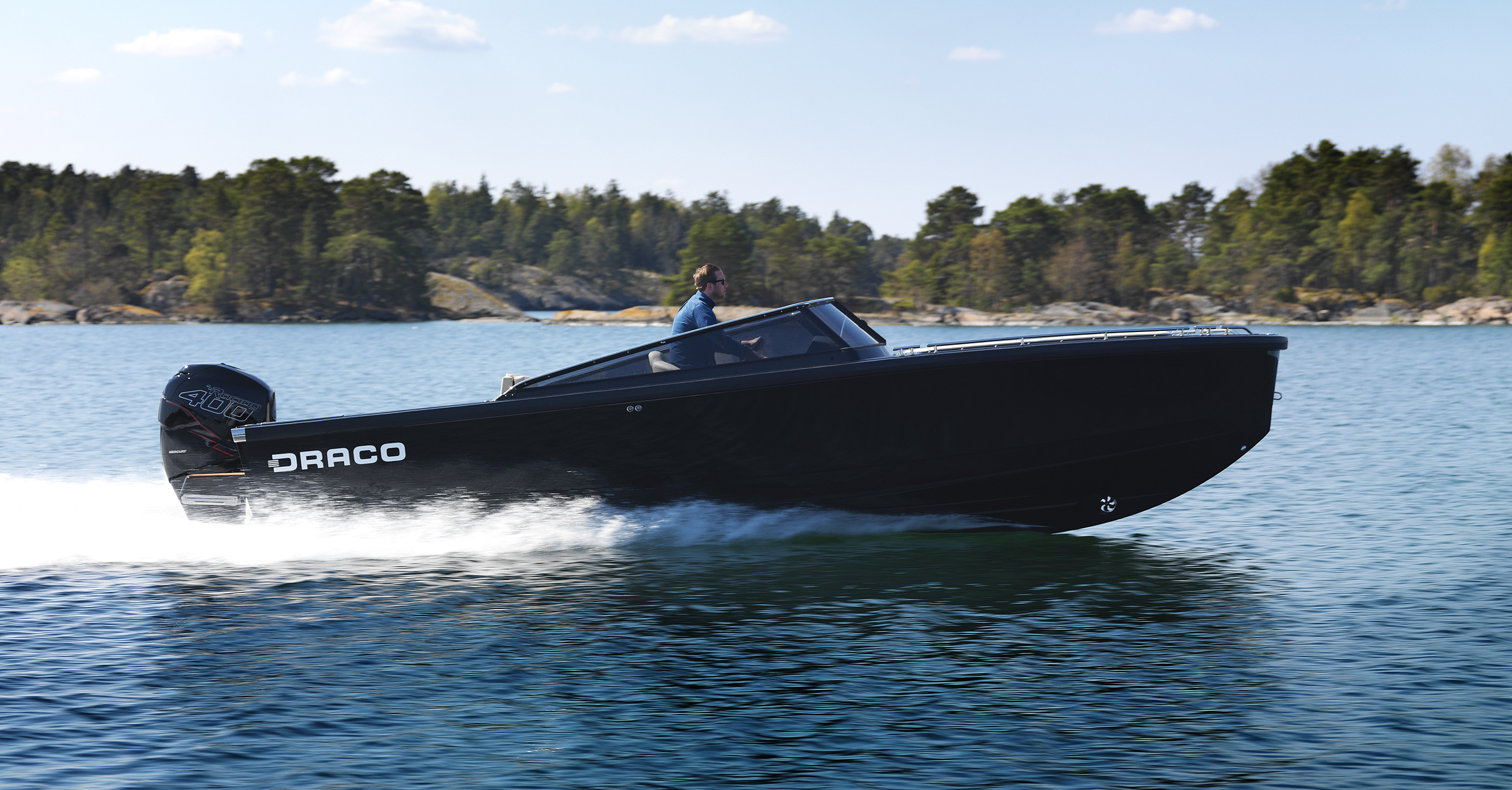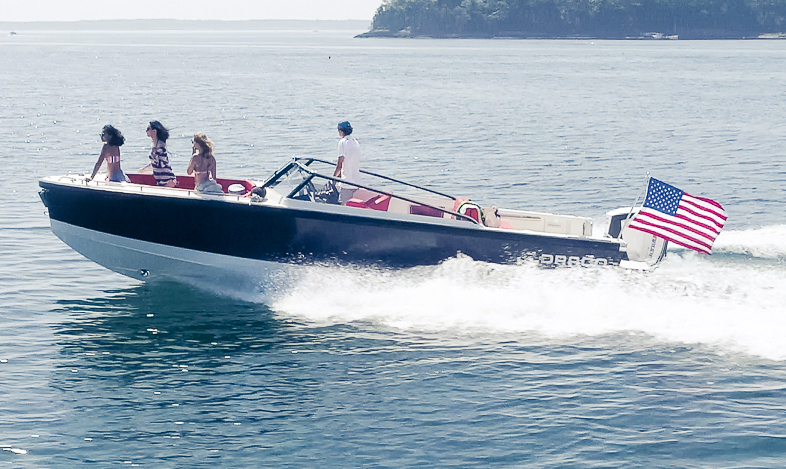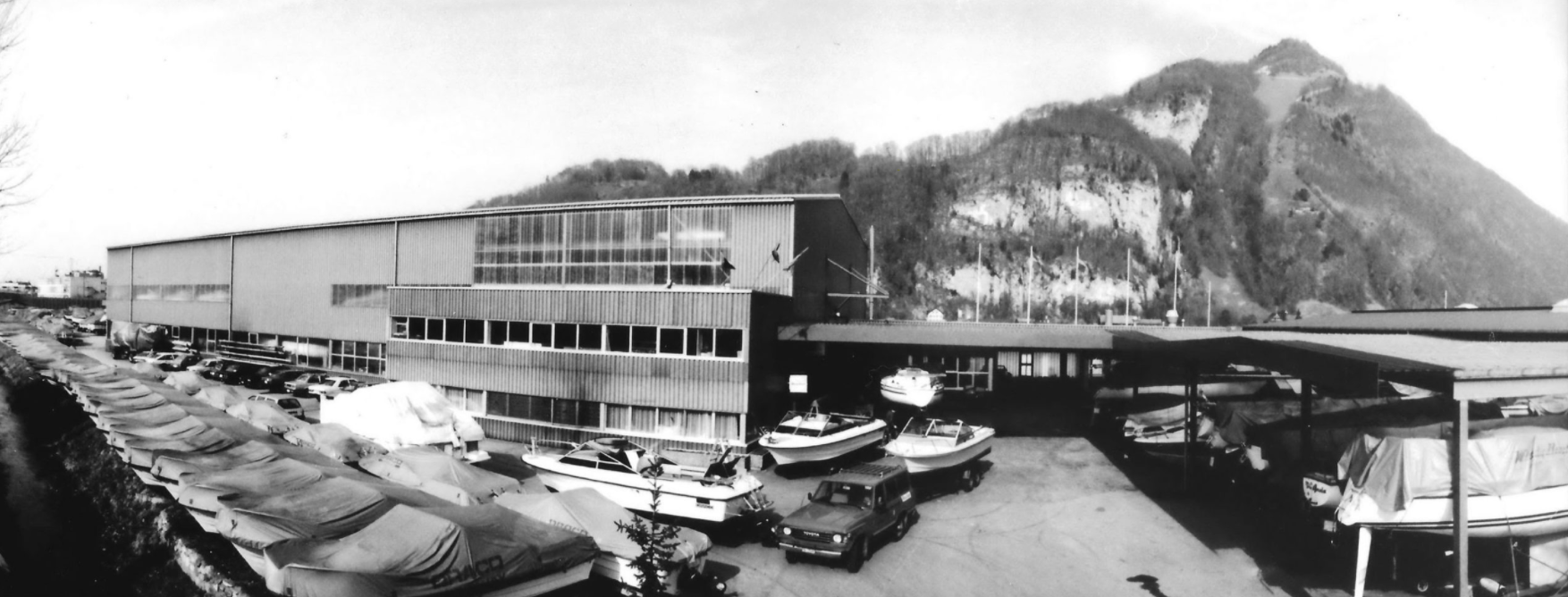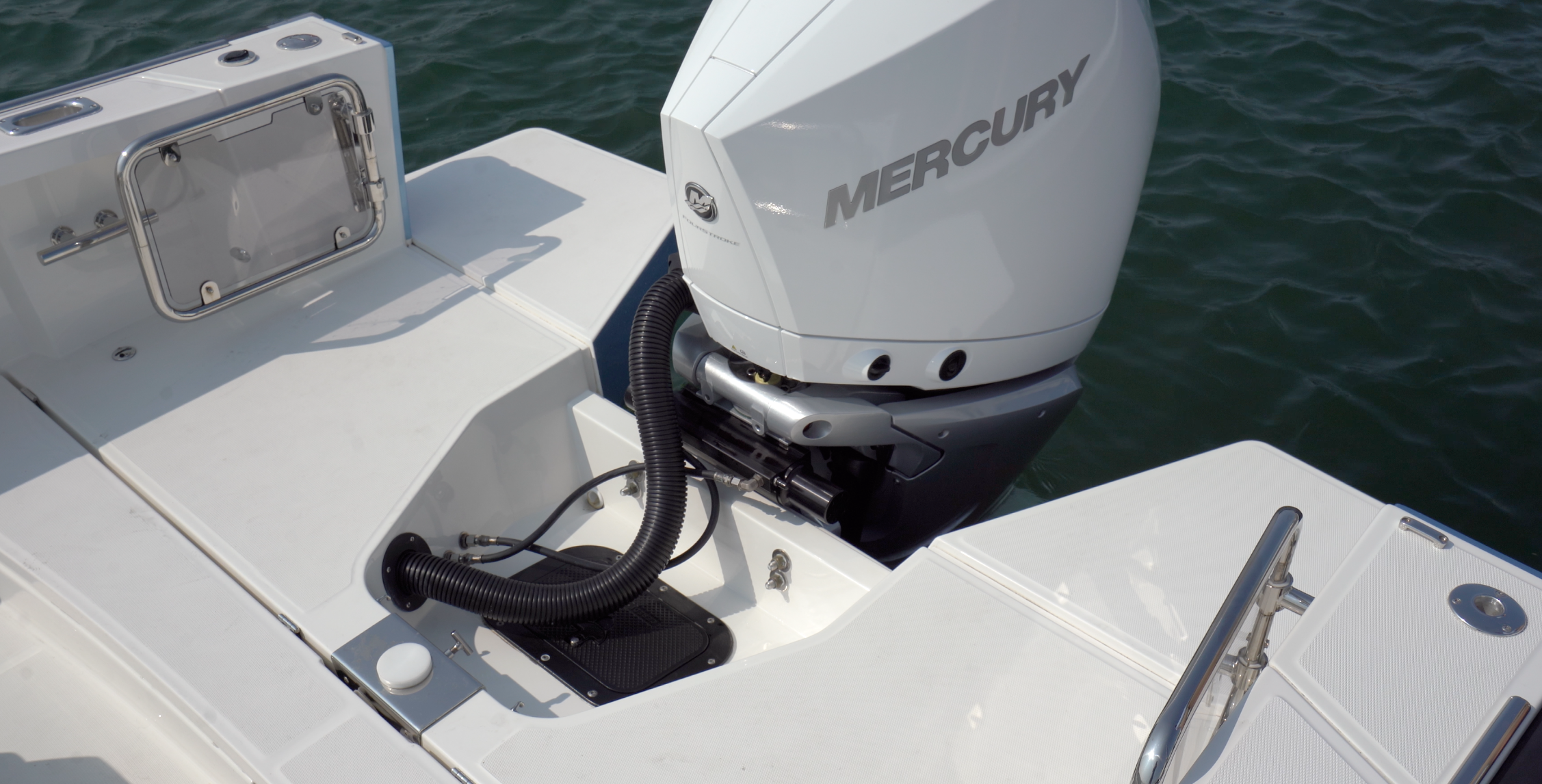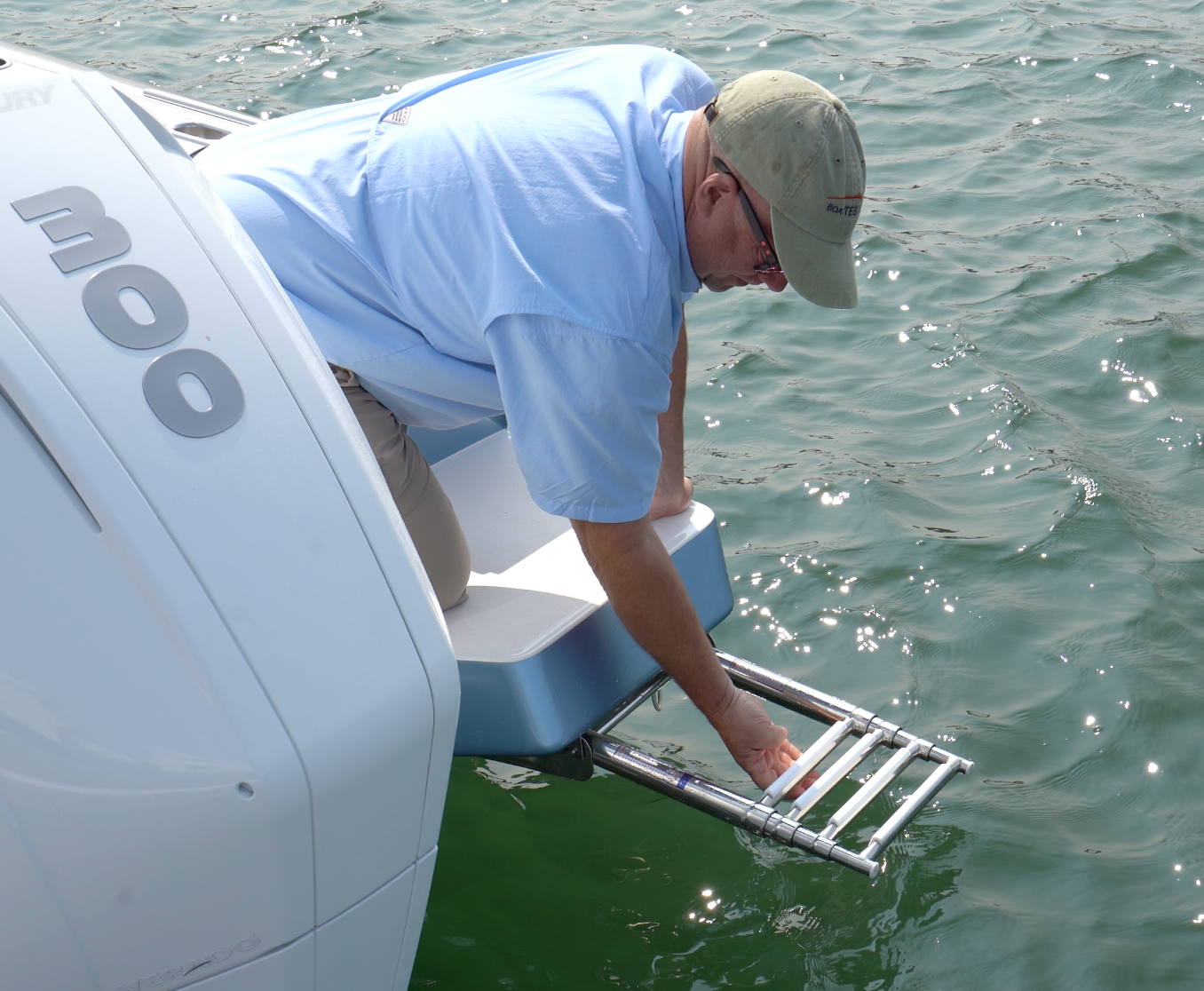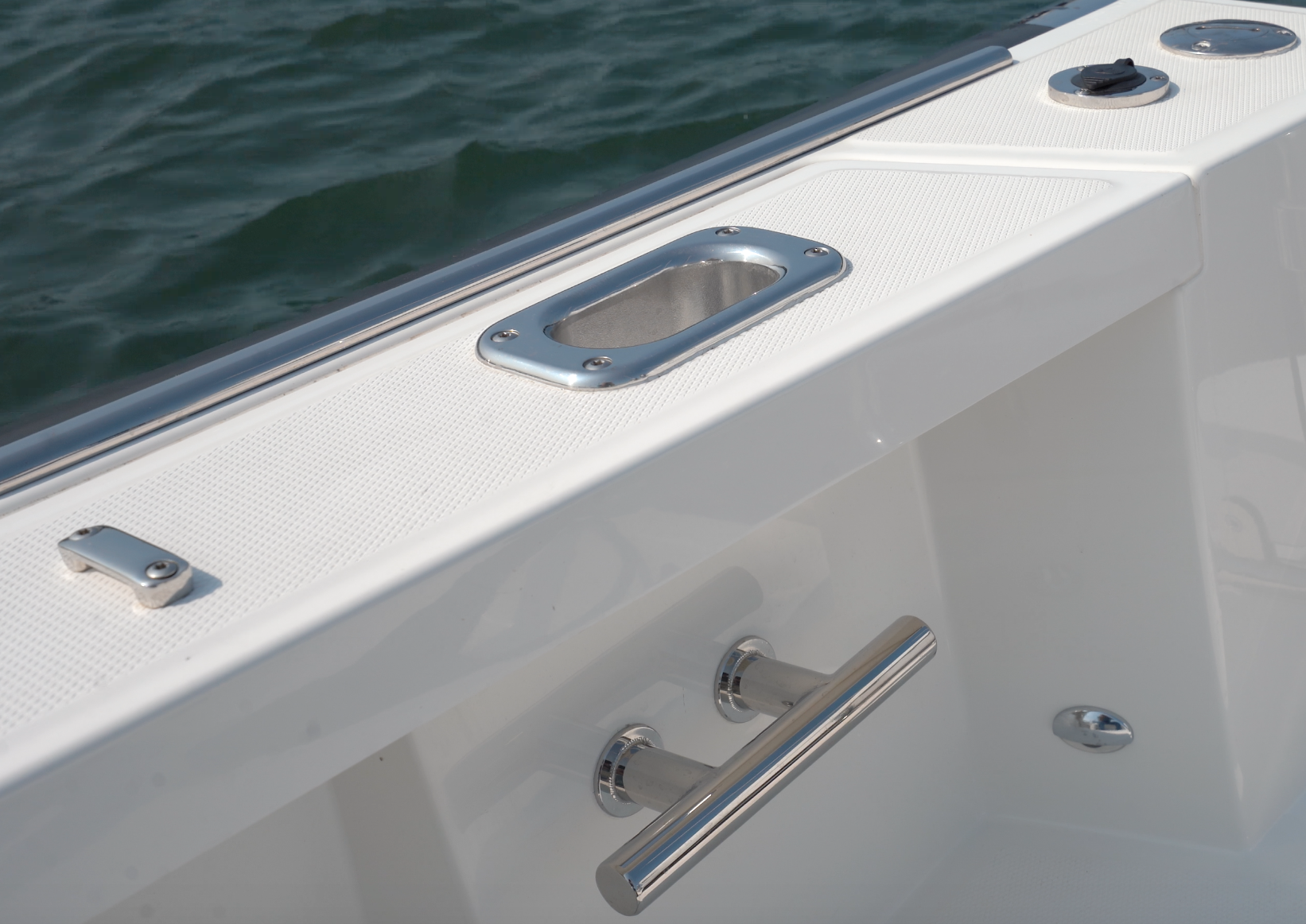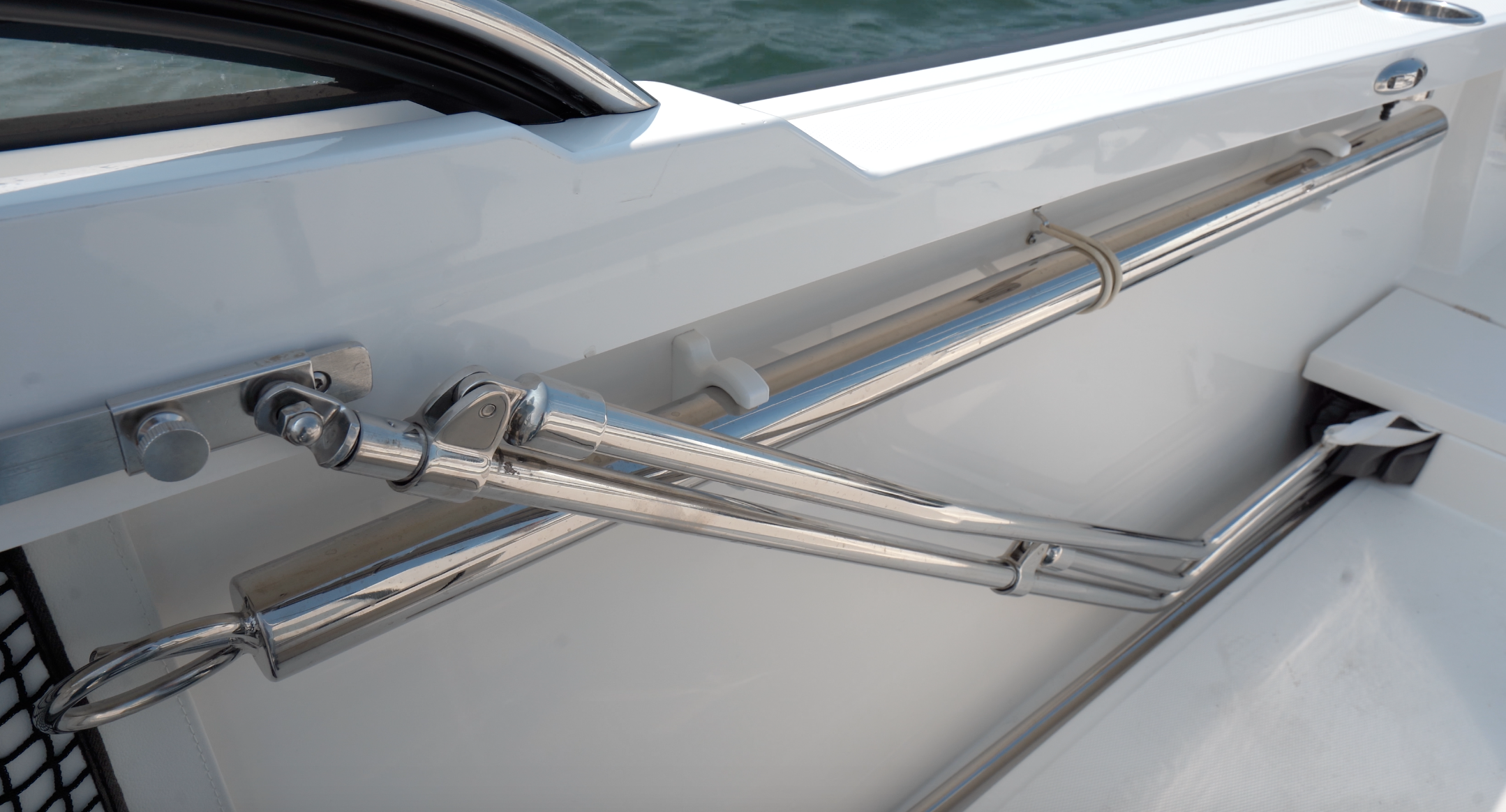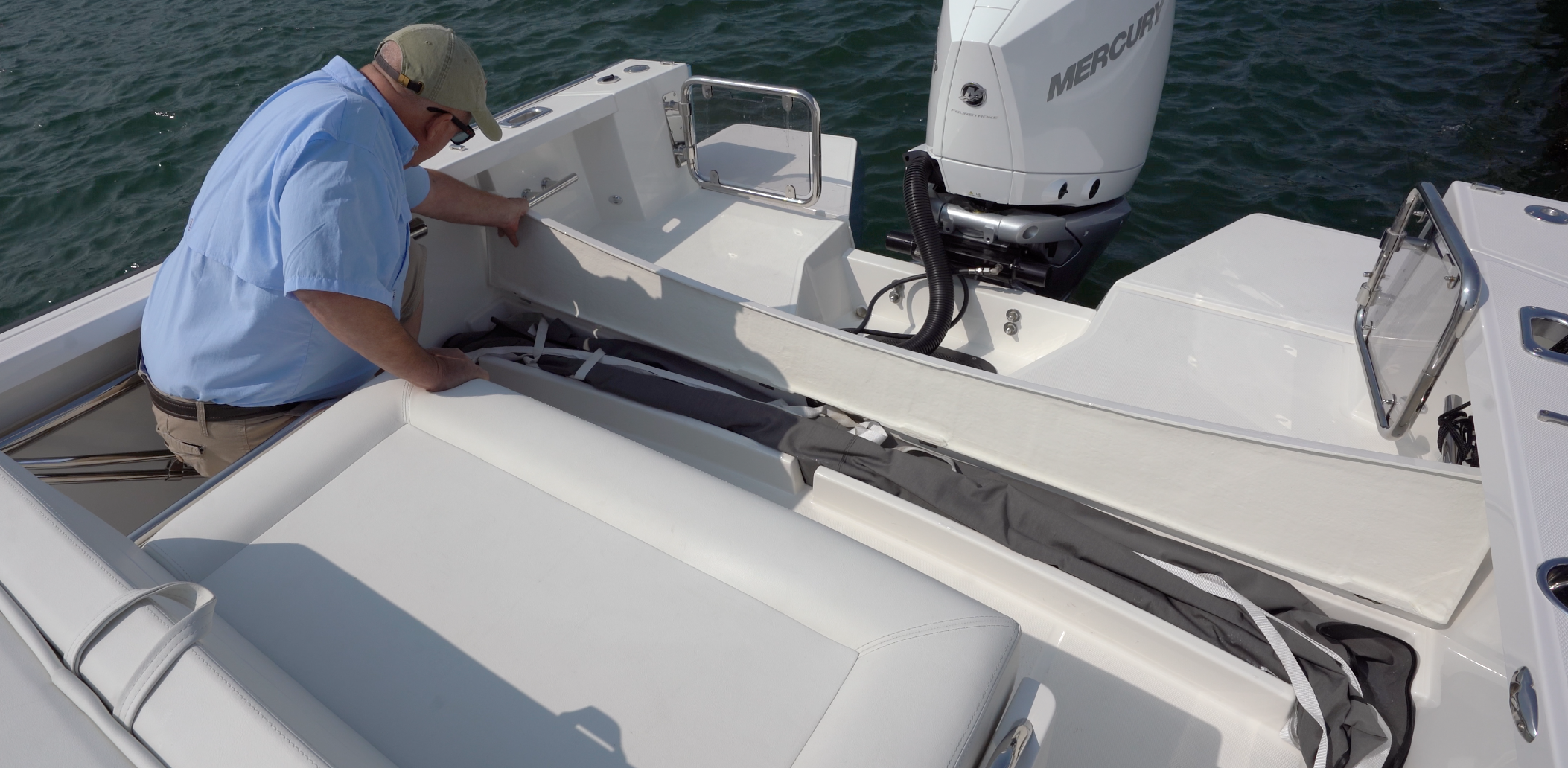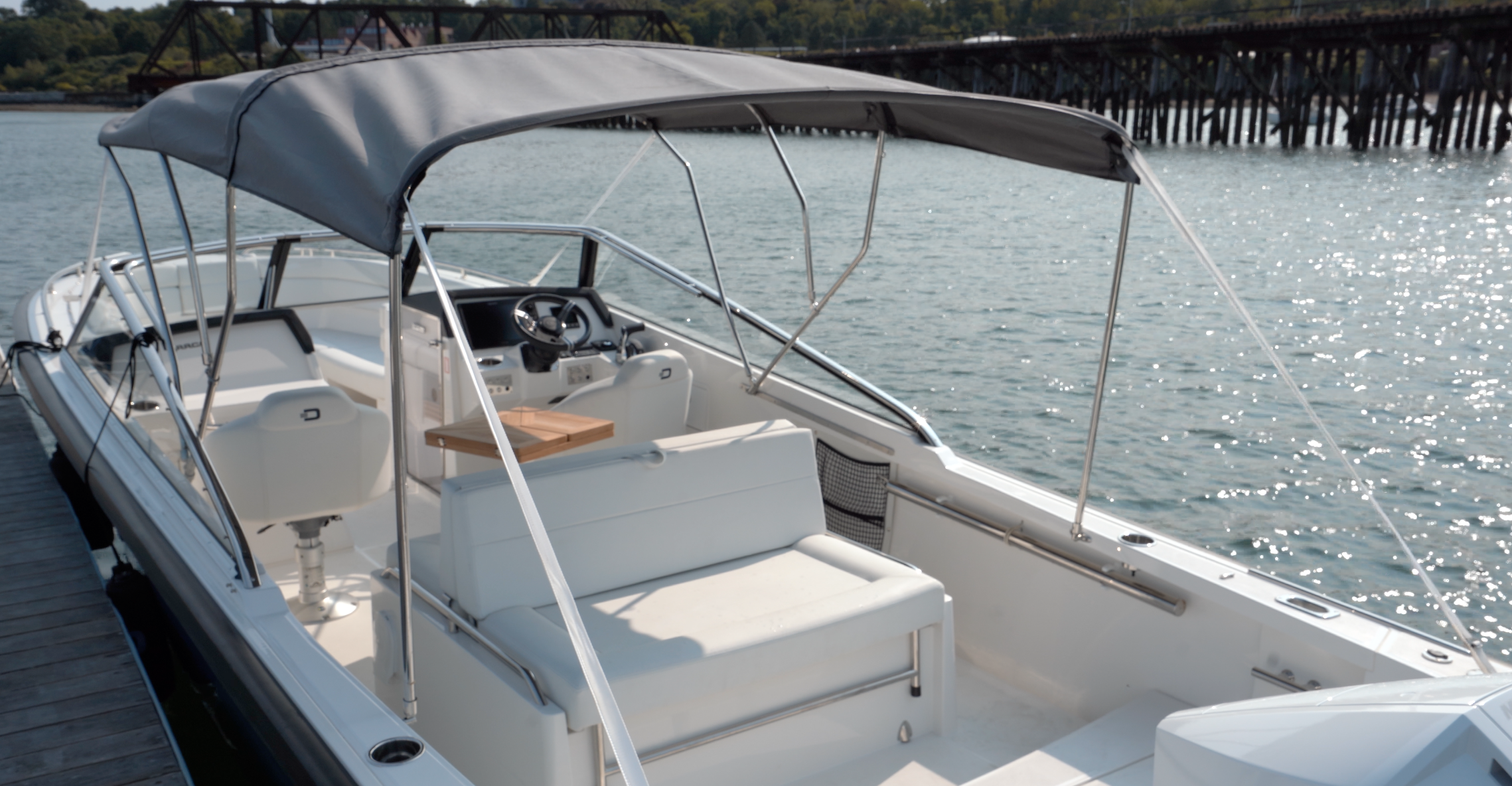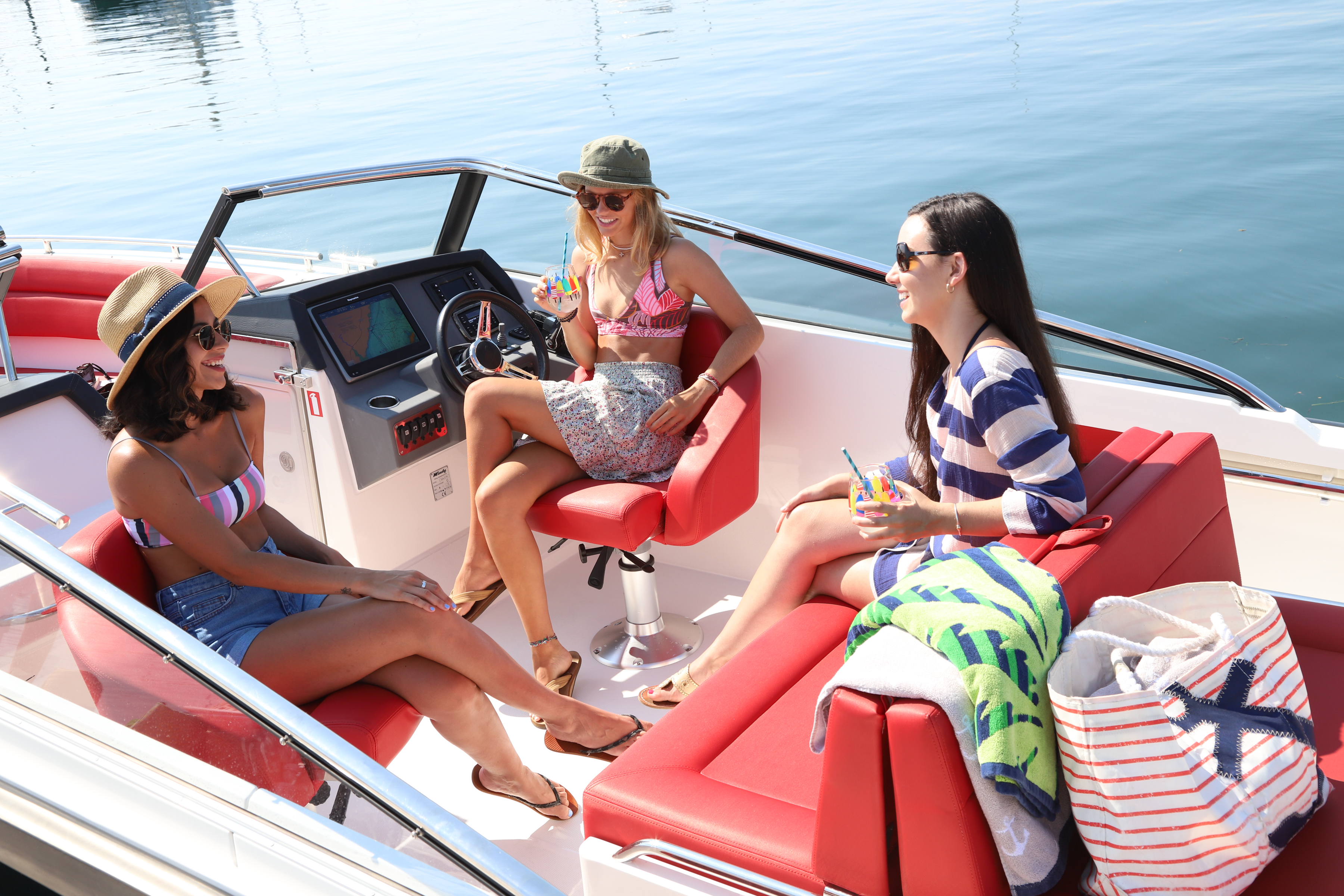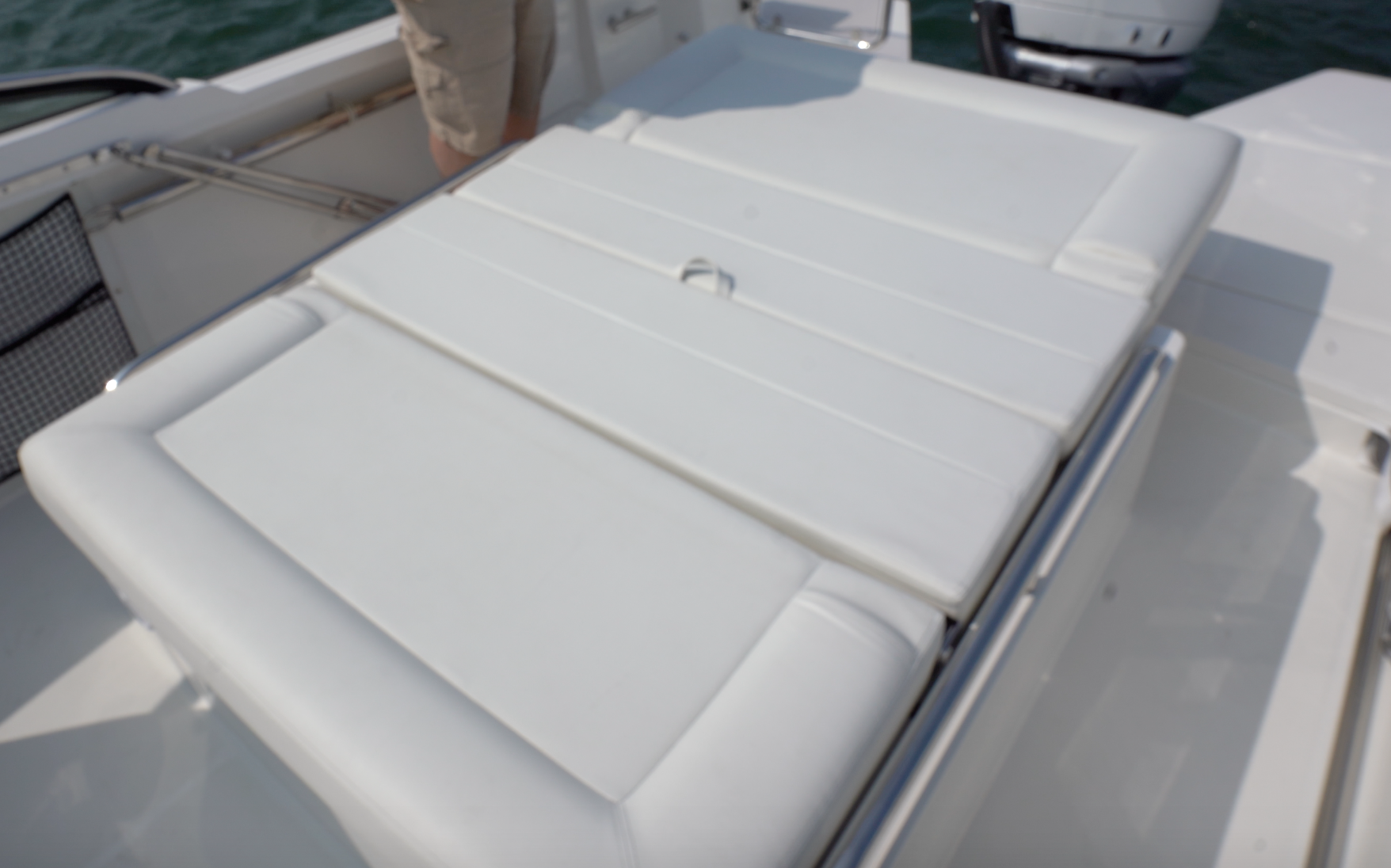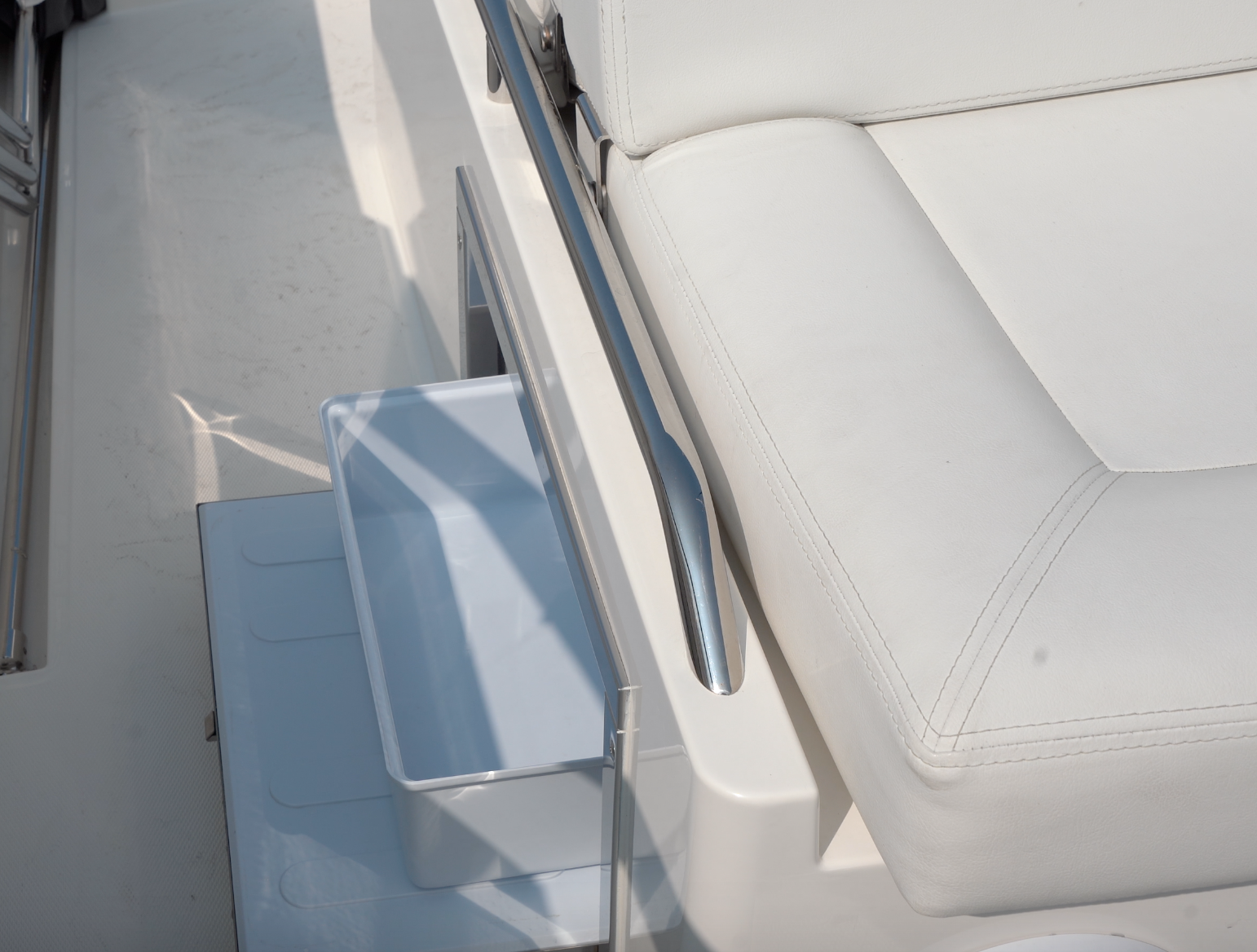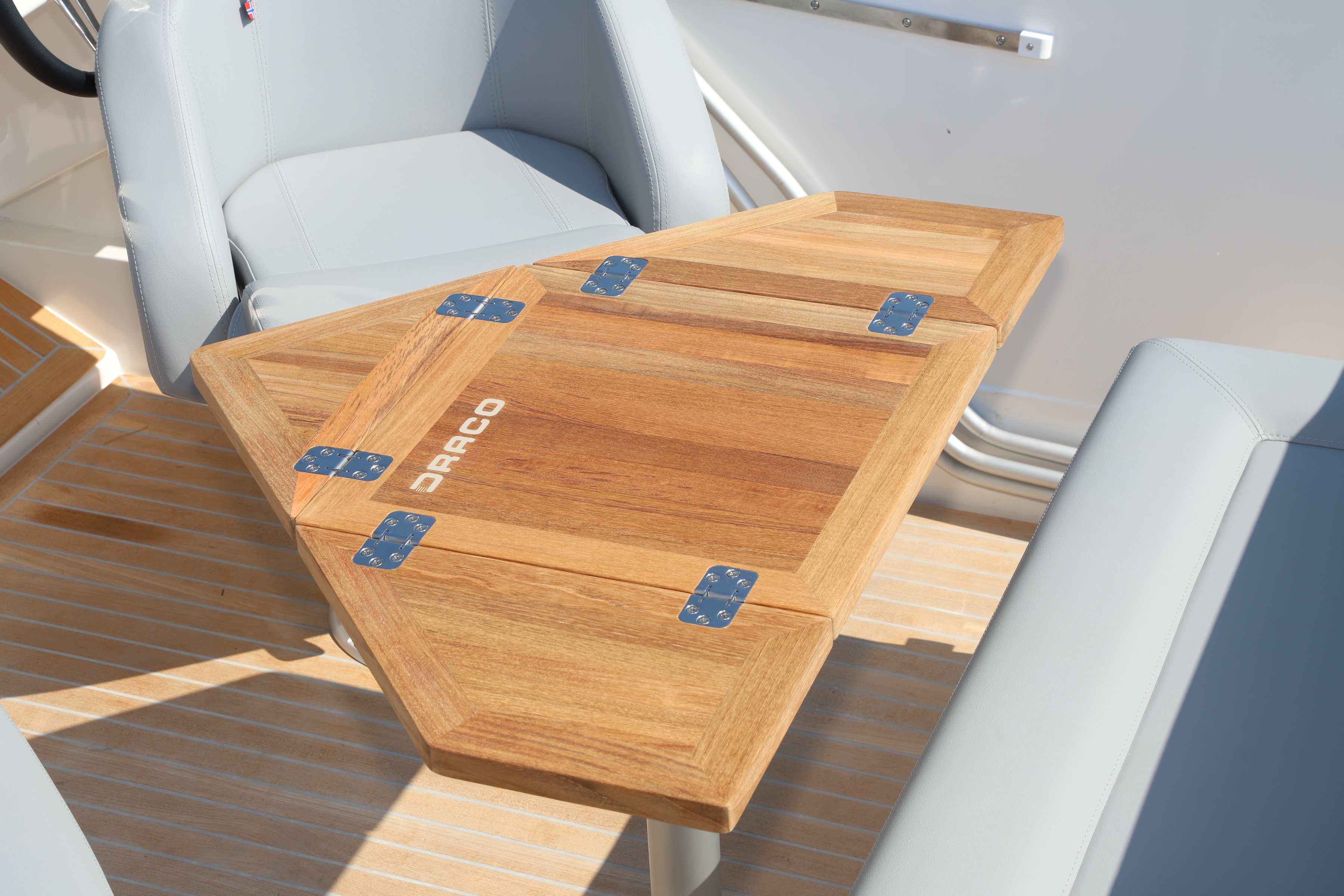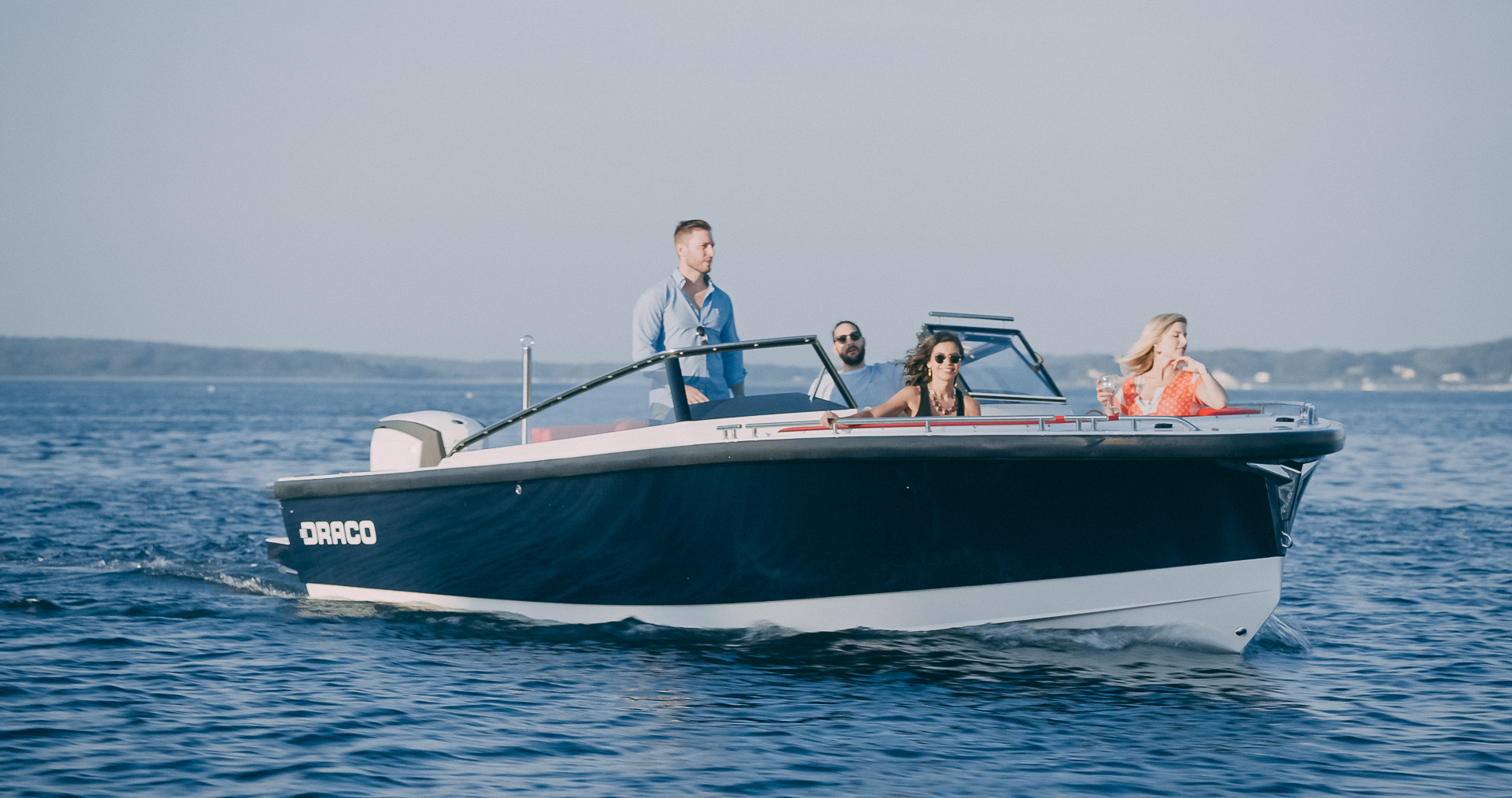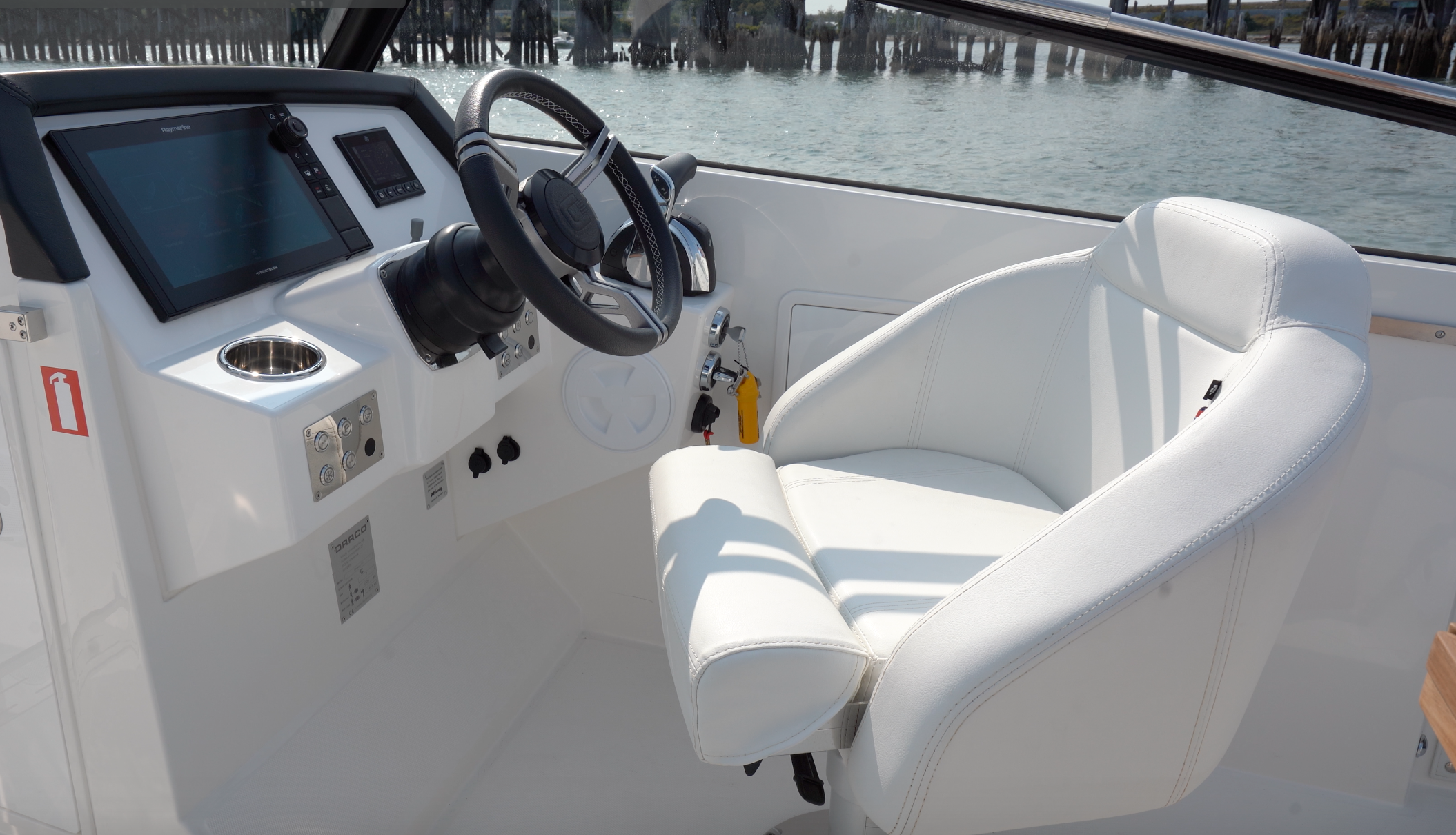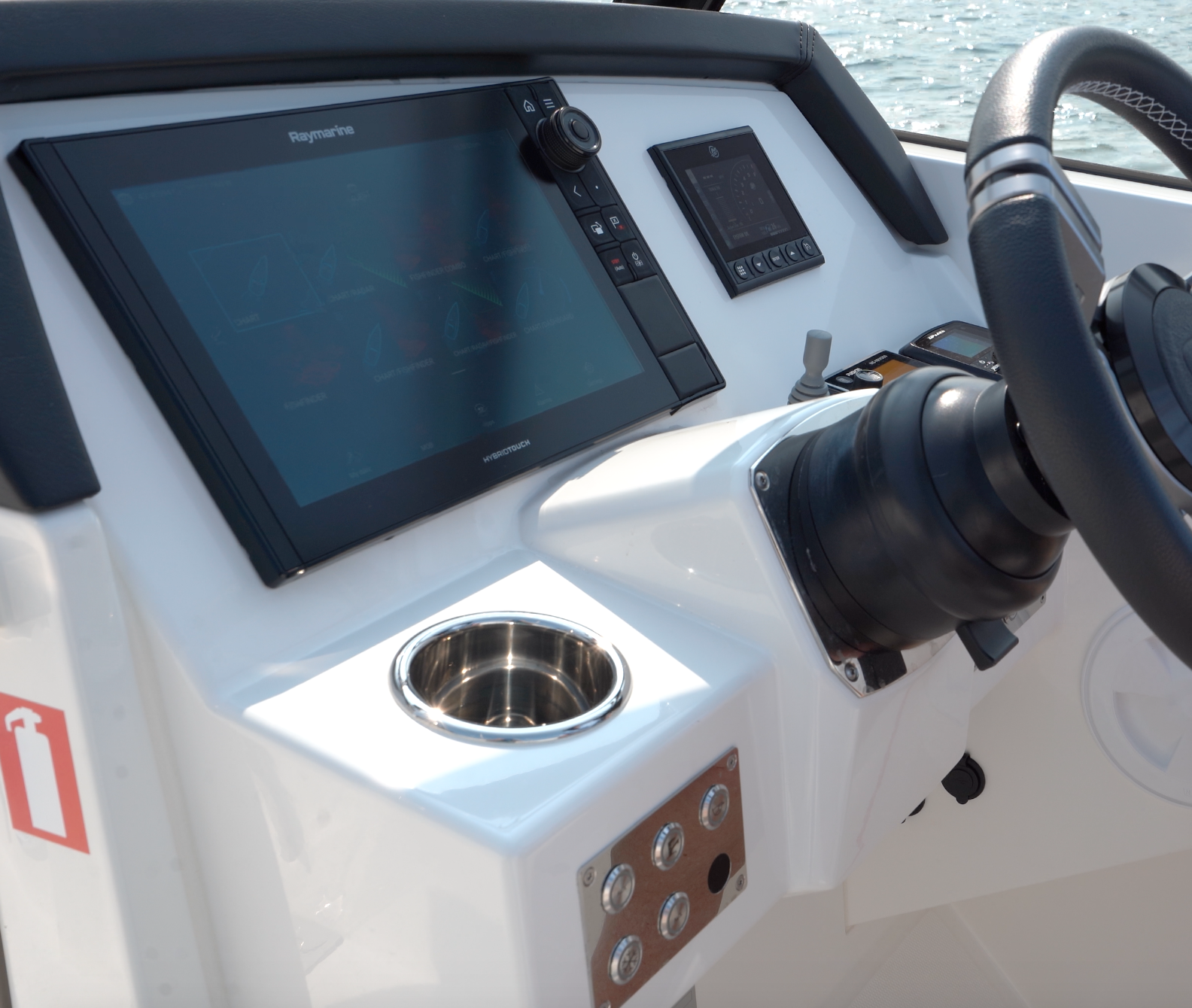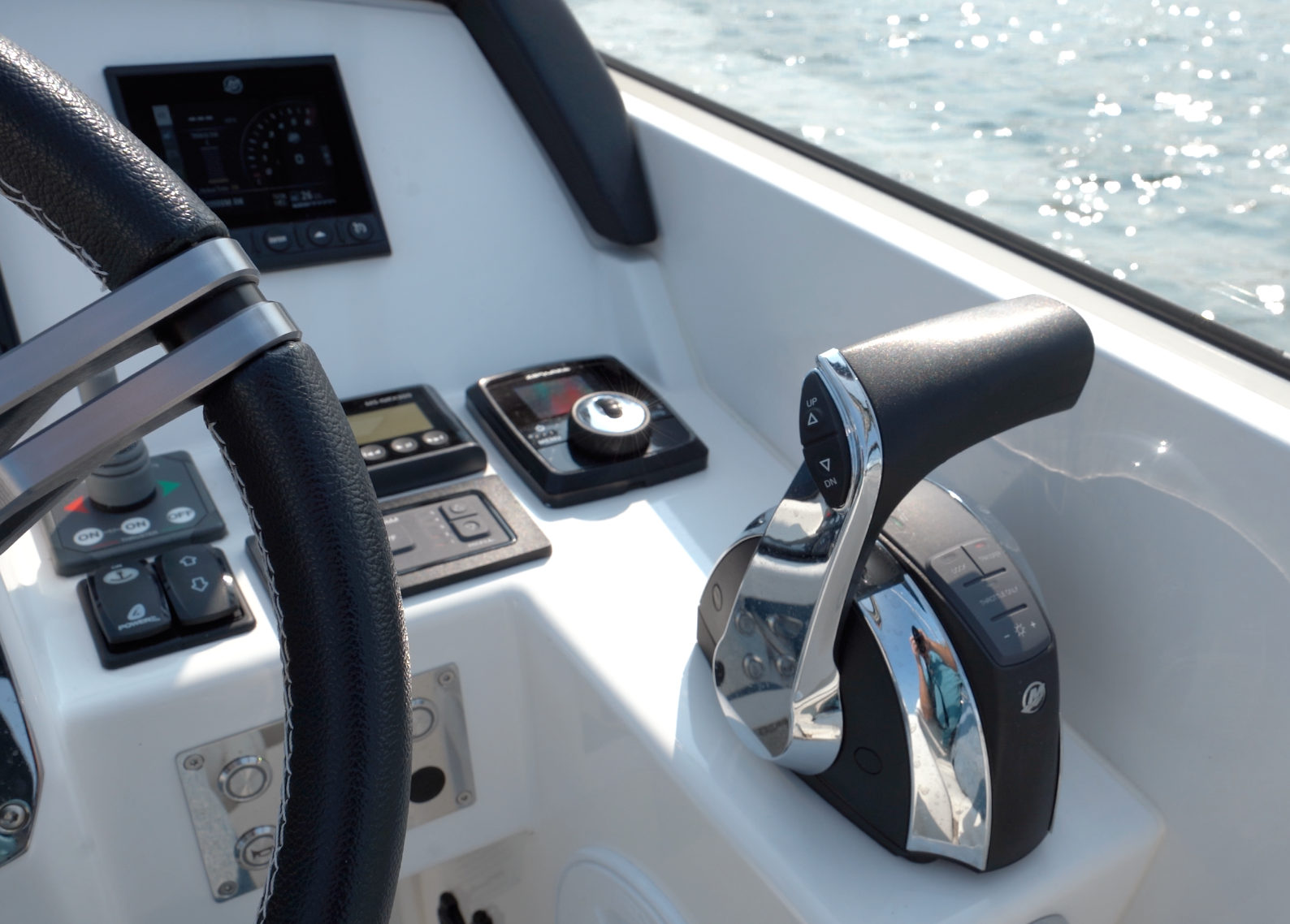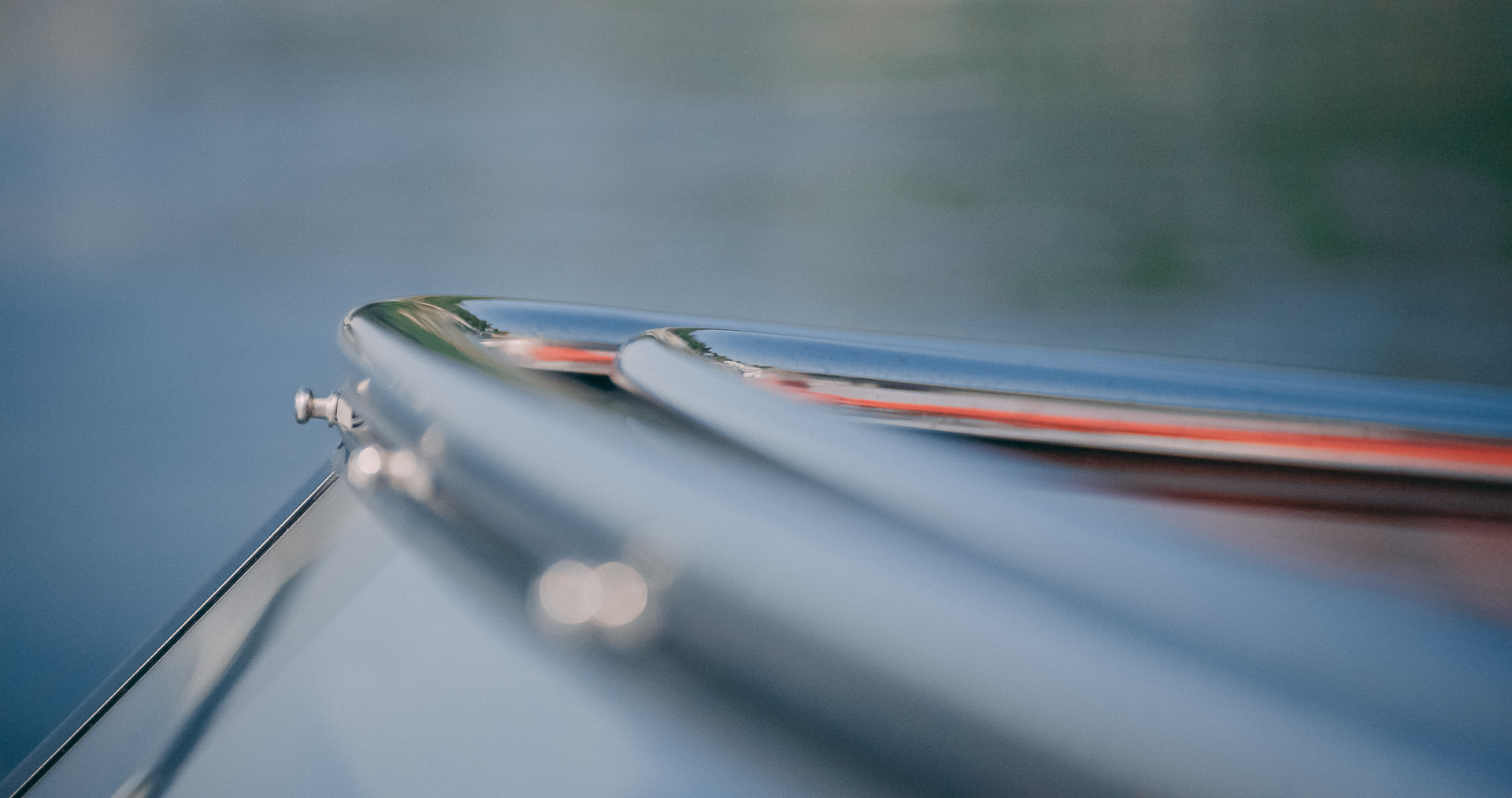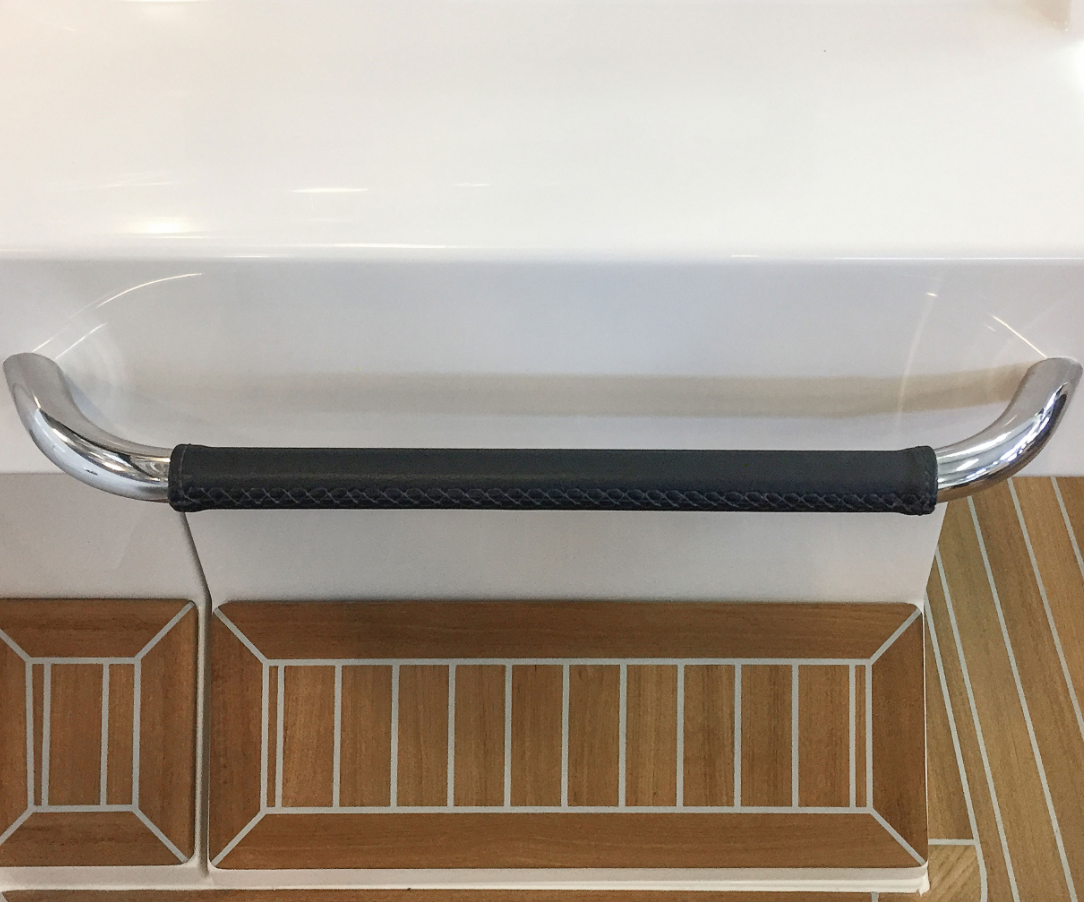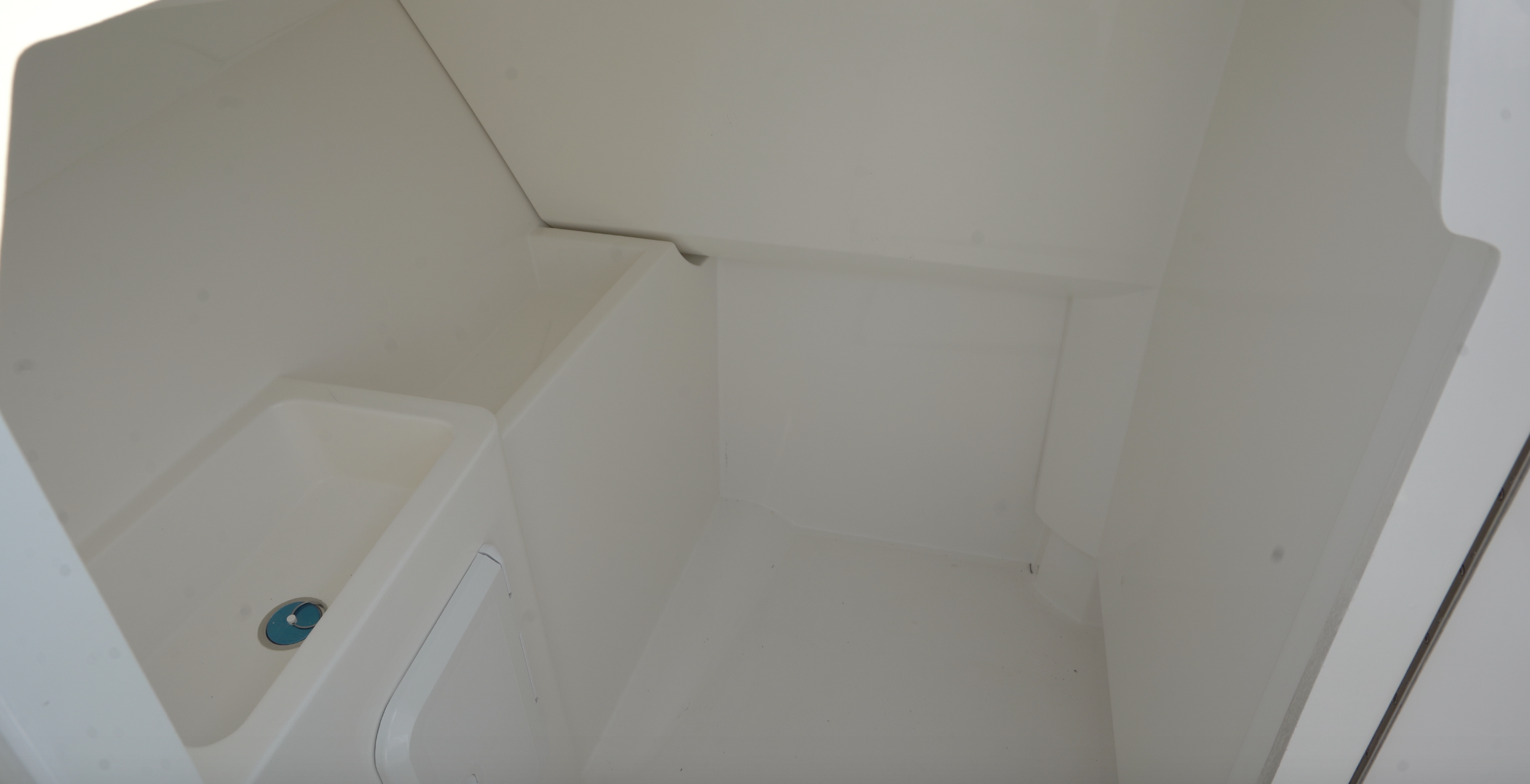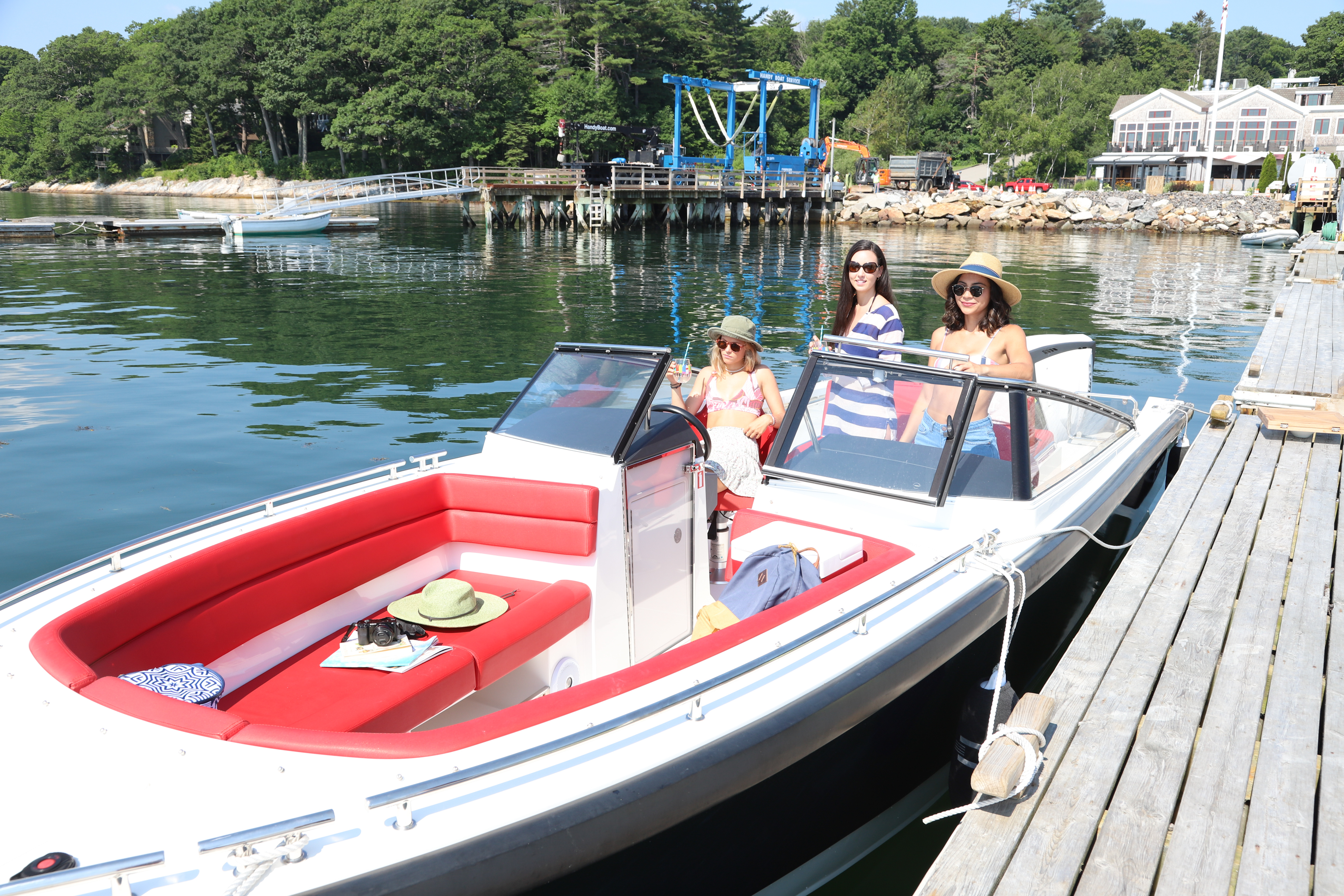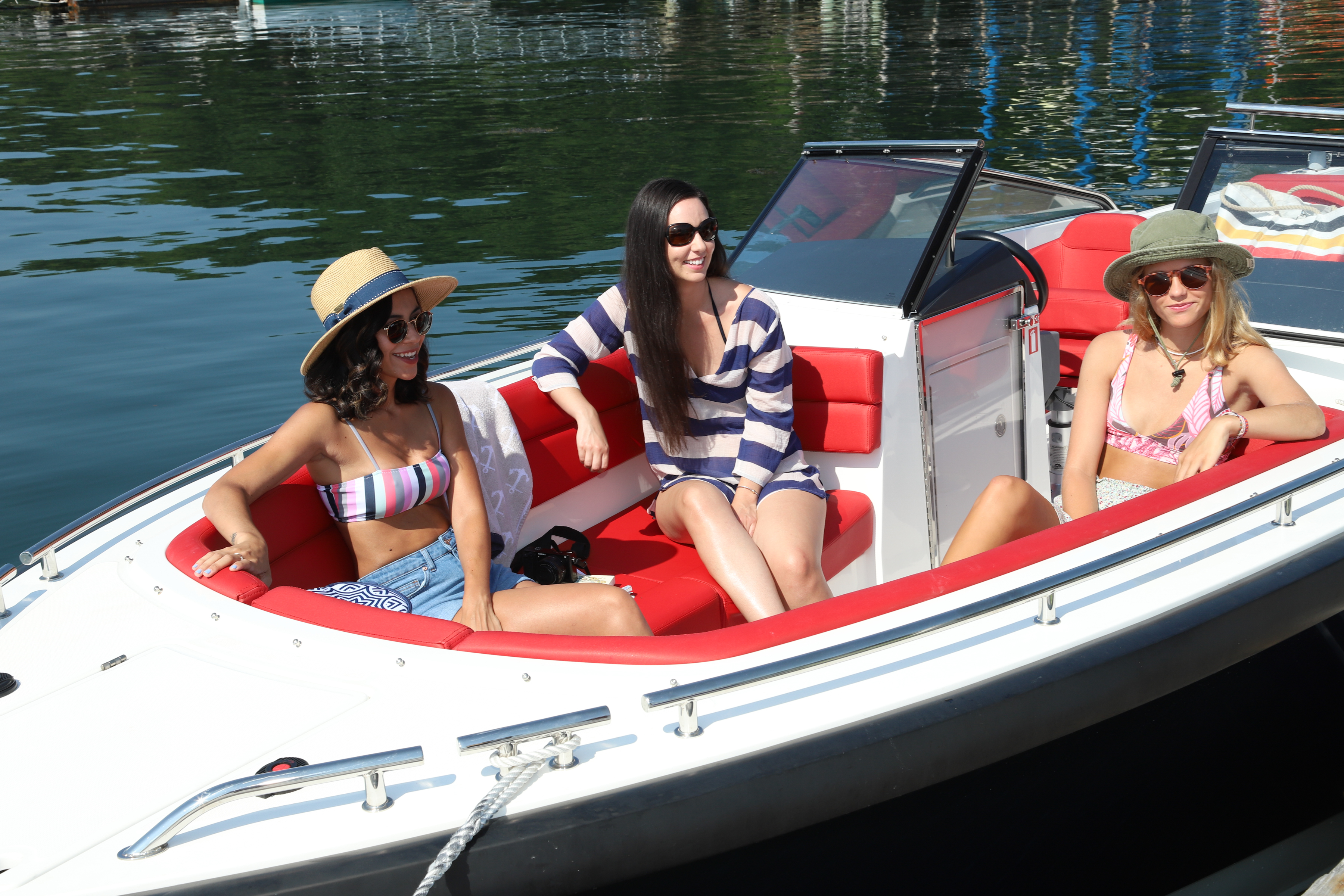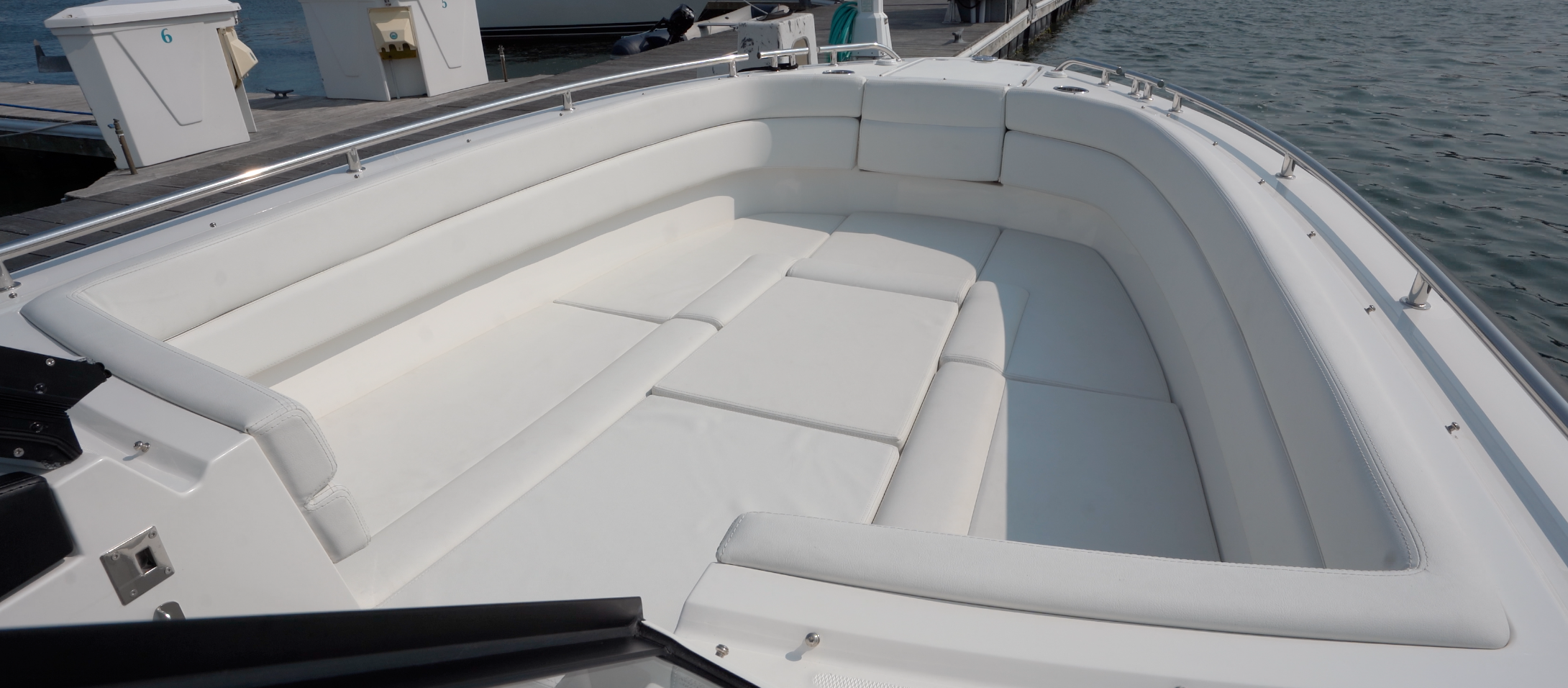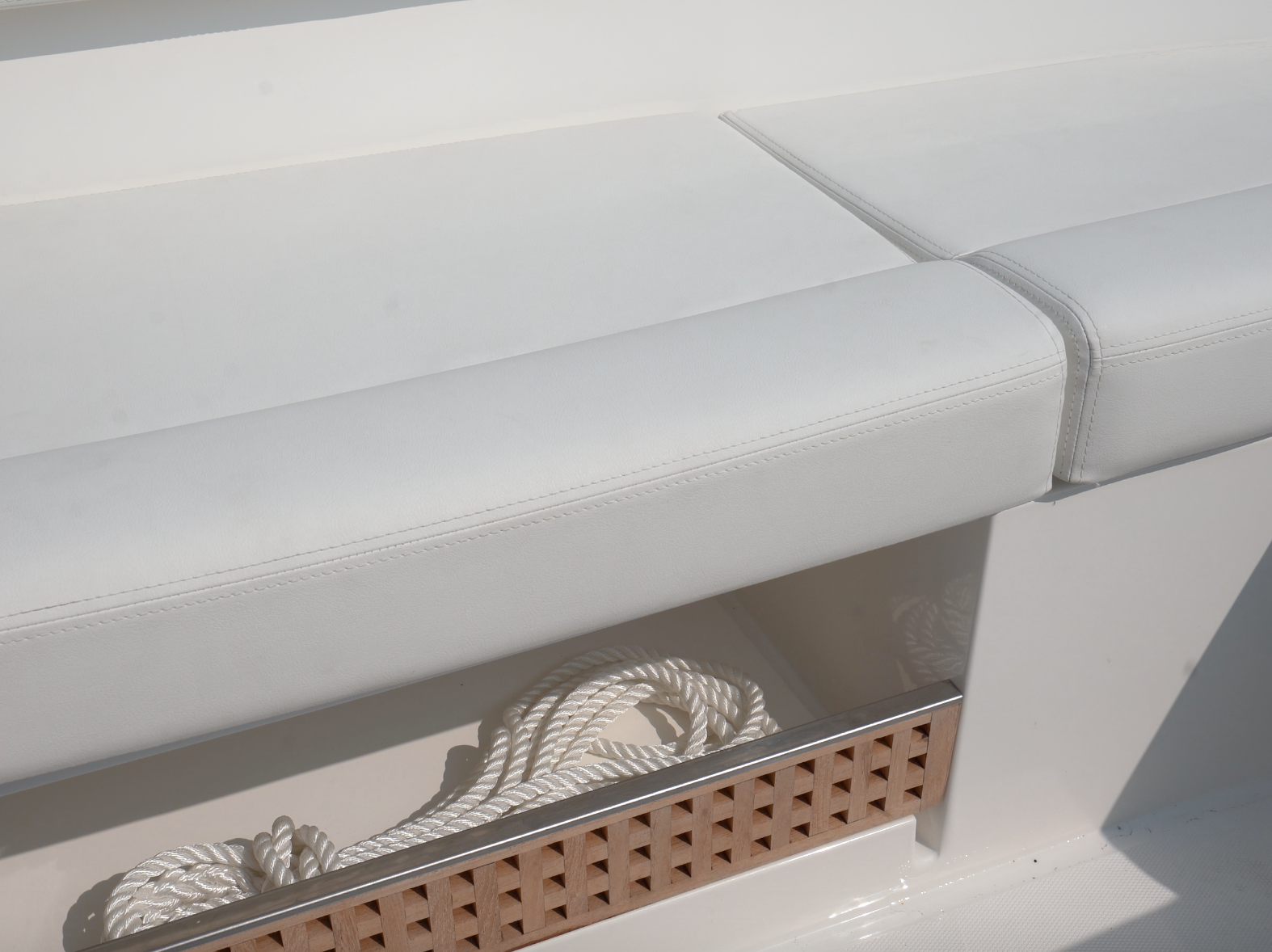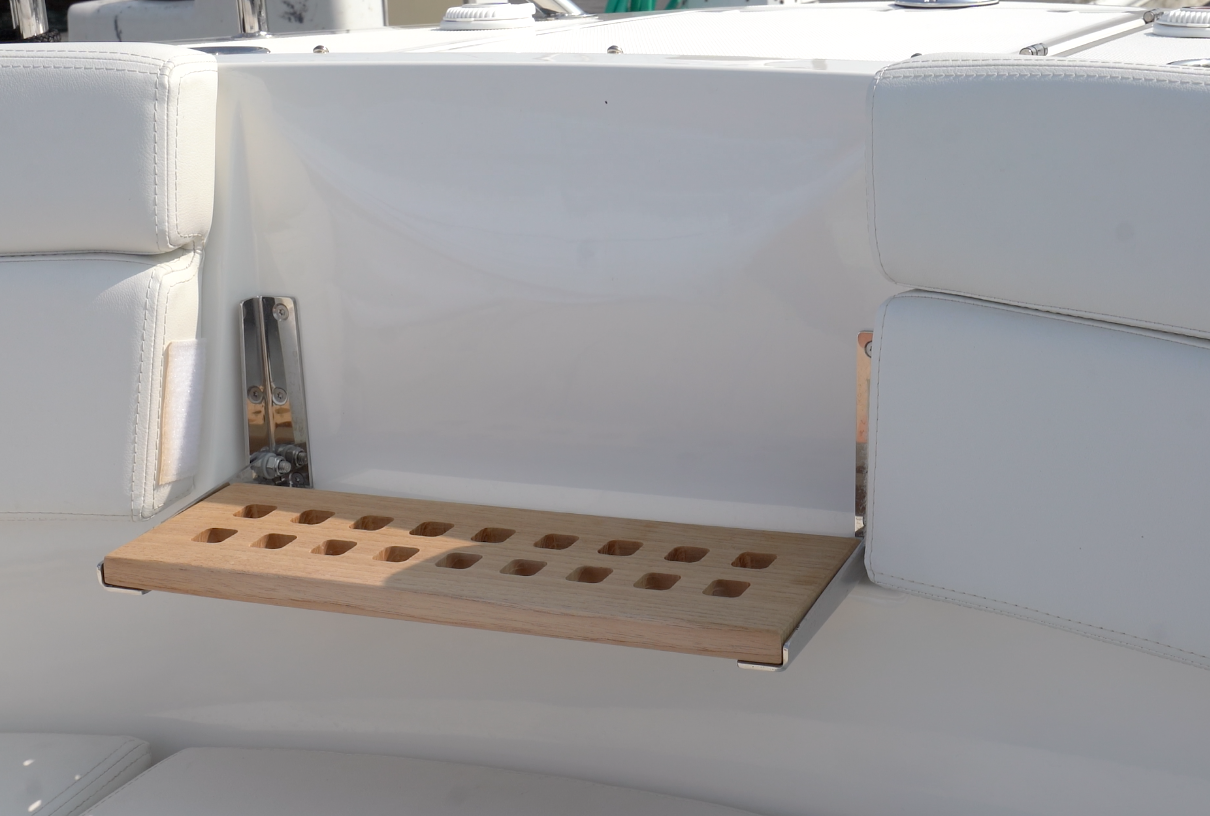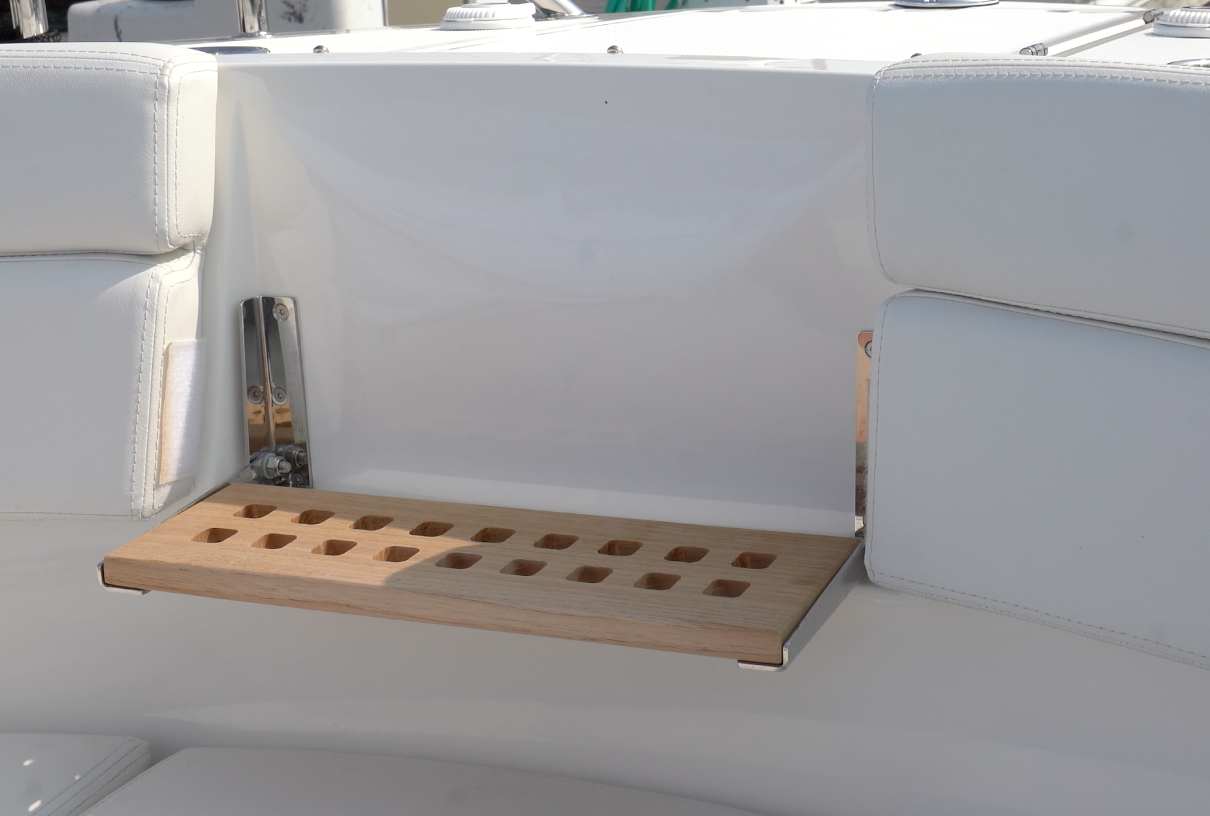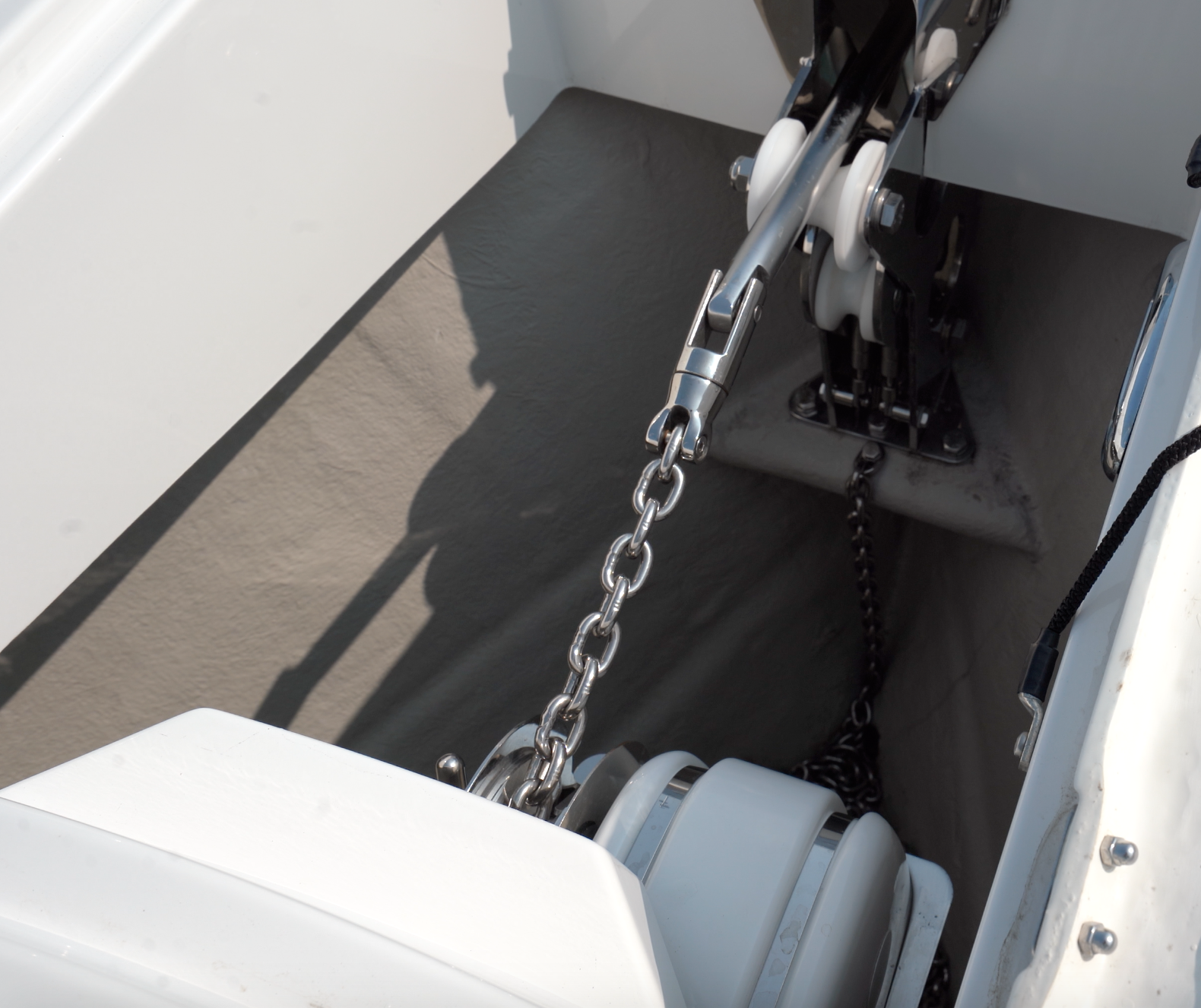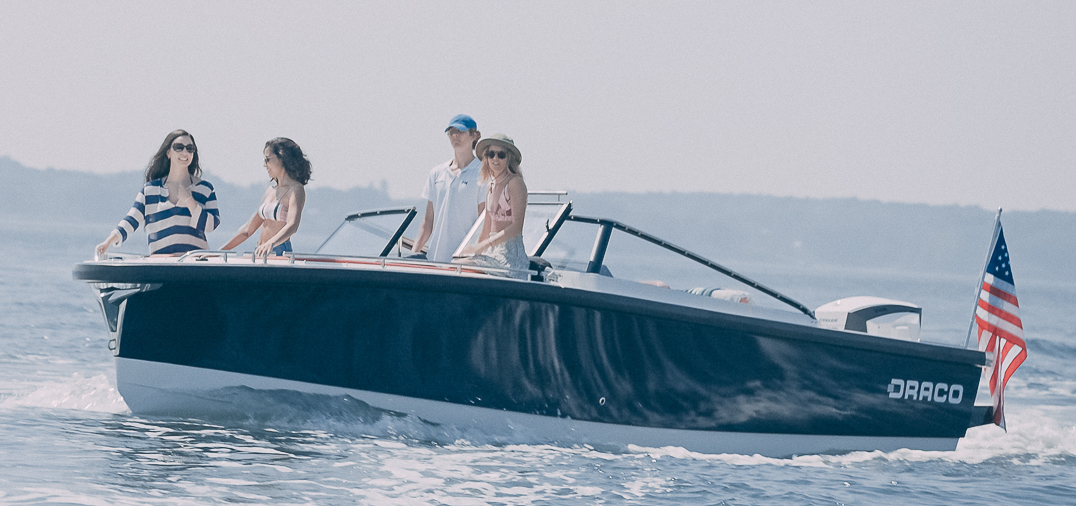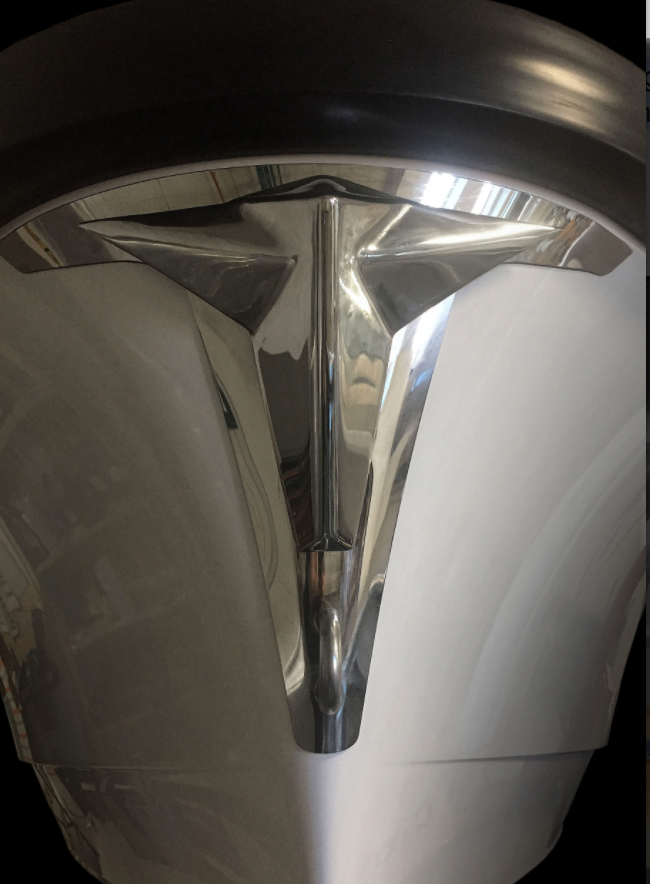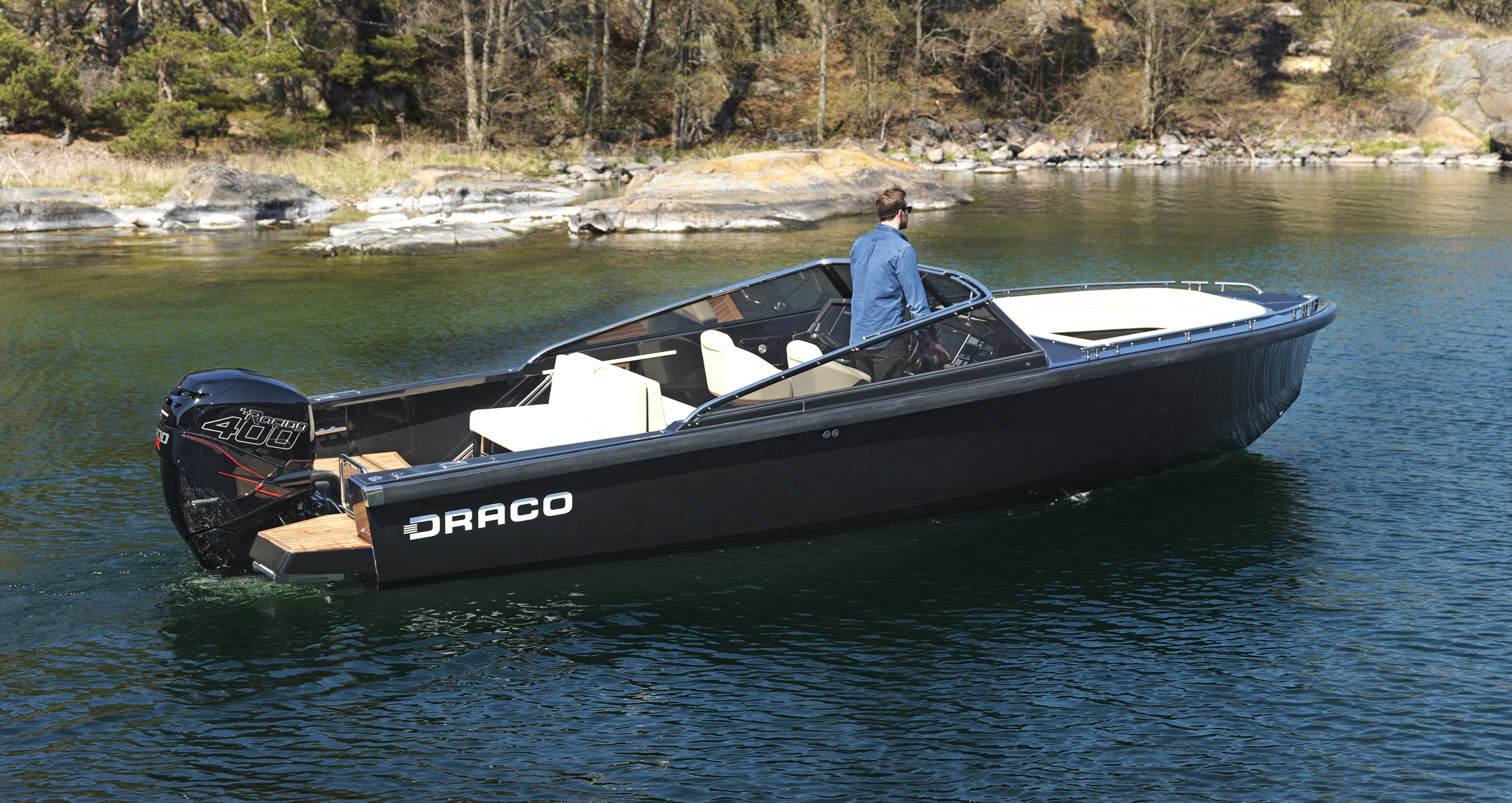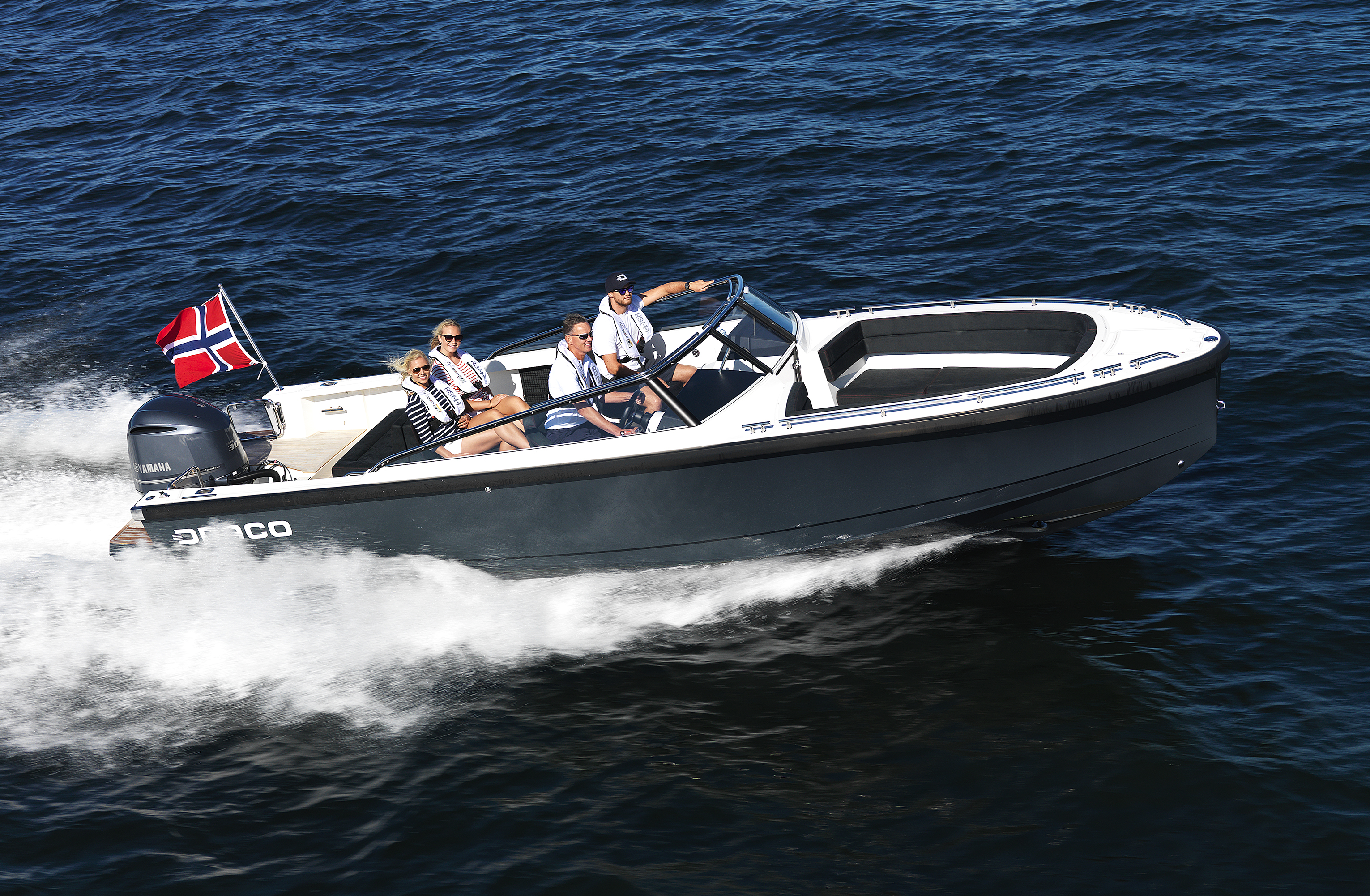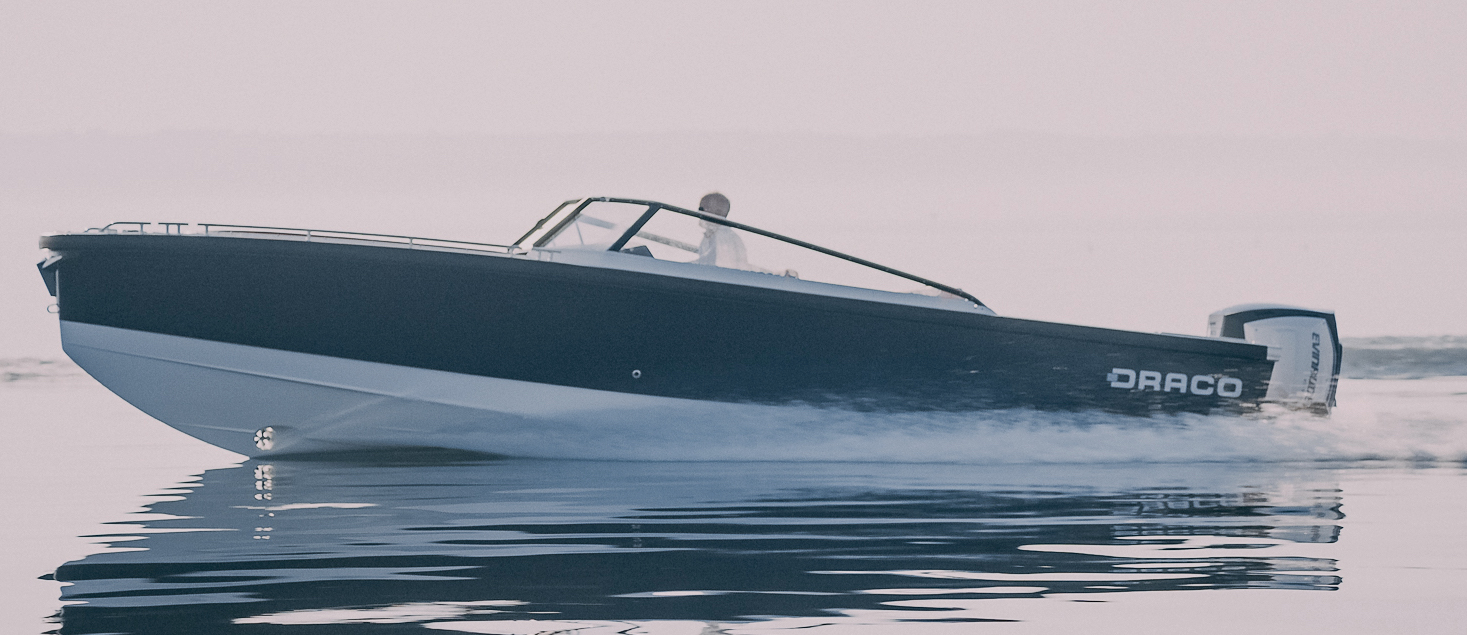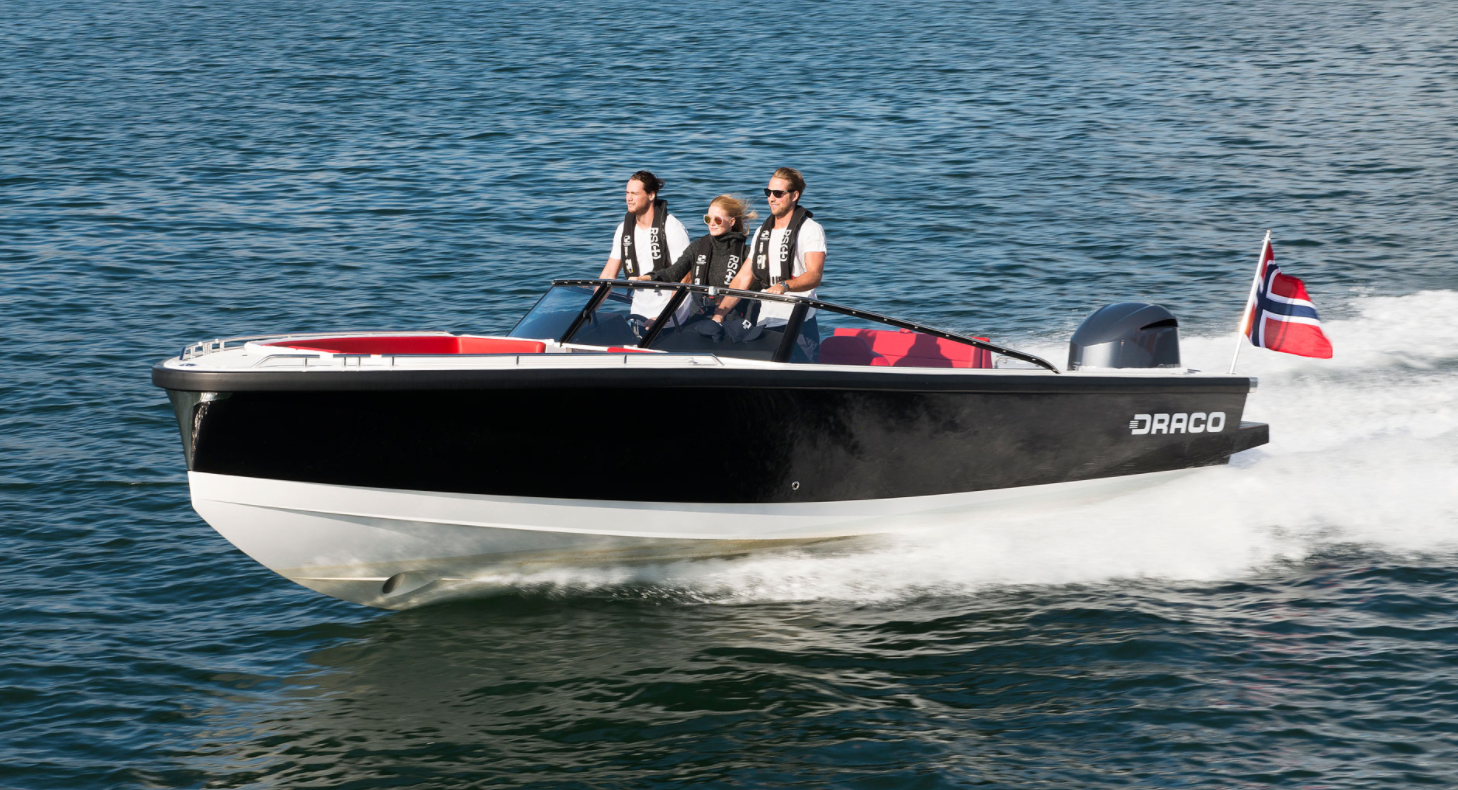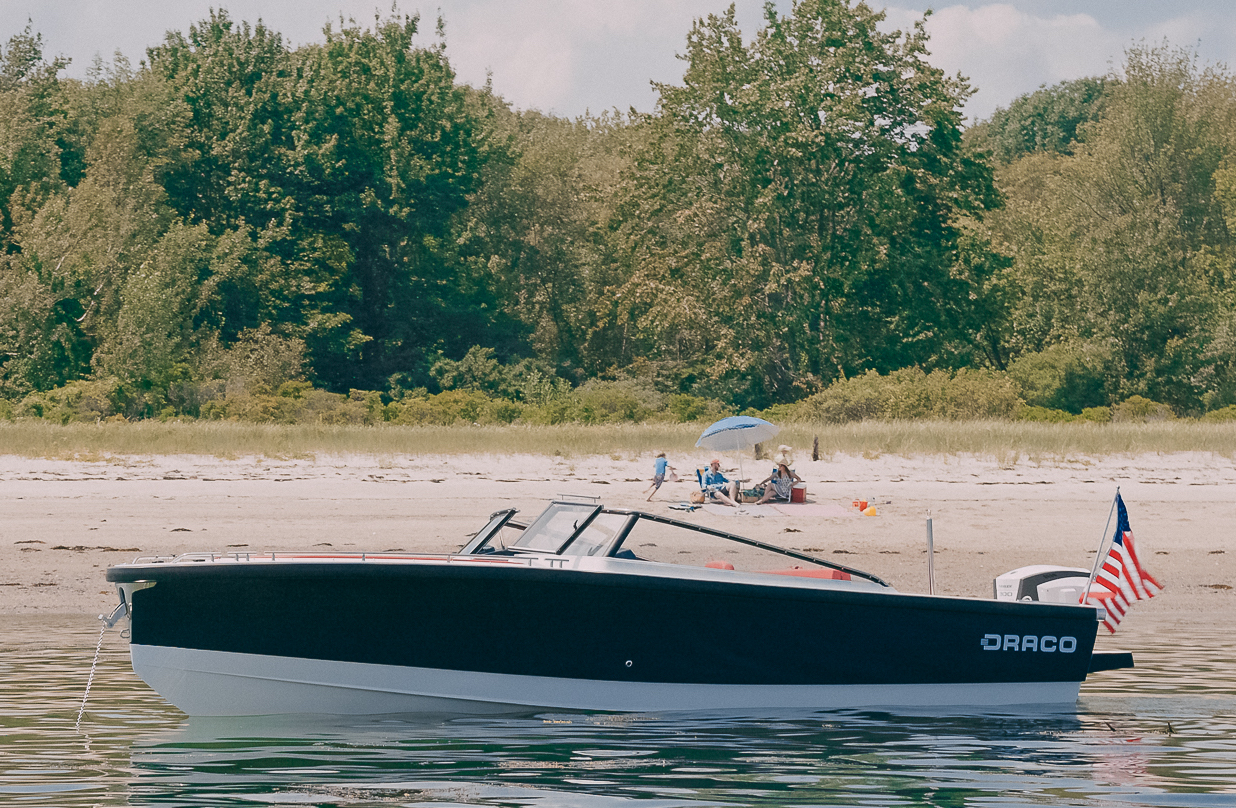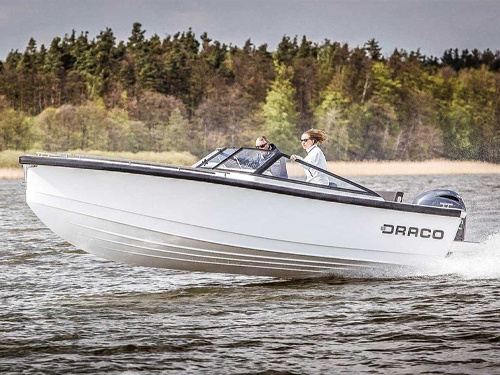Access More Boat Tests
Already have an account? Login
Draco Boats 27 (2020-)
1 x Mercury Verado 300
Brief Summary
The Draco 27 is a retro-styled dual console that has a mini-expedition feel. She’s powered by a single outboard and has convertible seating in the cockpit. For overnighting, owners can opt for a camper canopy, a refrigerator, a head and a shower.
Test Results
| RPM | MPH | Knots | GPH | MPG | NMPG | STAT. MILE | NM | dBa |
|---|---|---|---|---|---|---|---|---|
| 600 | 3.2 | 2.7 | 0.8 | 4.2 | 3.7 | 227 | 197.2 | 72 |
| 1000 | 5 | 4.3 | 1.3 | 3.8 | 3.3 | 208 | 180.6 | 74 |
| 1500 | 7.8 | 6.8 | 2 | 3.9 | 3.4 | 211 | 183.1 | 73 |
| 2000 | 9.4 | 8.1 | 3.2 | 2.9 | 2.5 | 158 | 137.2 | 72 |
| 2500 | 12.3 | 10.7 | 4.2 | 3 | 2.6 | 160 | 139.2 | 72 |
| 3000 | 16.6 | 14.4 | 5.6 | 3 | 2.6 | 160 | 138.8 | 74 |
| 3500 | 21.5 | 18.7 | 7.7 | 2.8 | 2.4 | 152 | 132 | 75 |
| 4000 | 30.6 | 26.6 | 10.7 | 2.9 | 2.5 | 155 | 134.9 | 76 |
| 4500 | 35.5 | 30.9 | 14.1 | 2.5 | 2.2 | 136 | 118.2 | 75 |
| 5000 | 39.7 | 34.5 | 21.2 | 1.9 | 1.6 | 101 | 88.1 | 78 |
| 5500 | 45.7 | 39.7 | 25.4 | 1.8 | 1.6 | 97 | 84.5 | 79 |
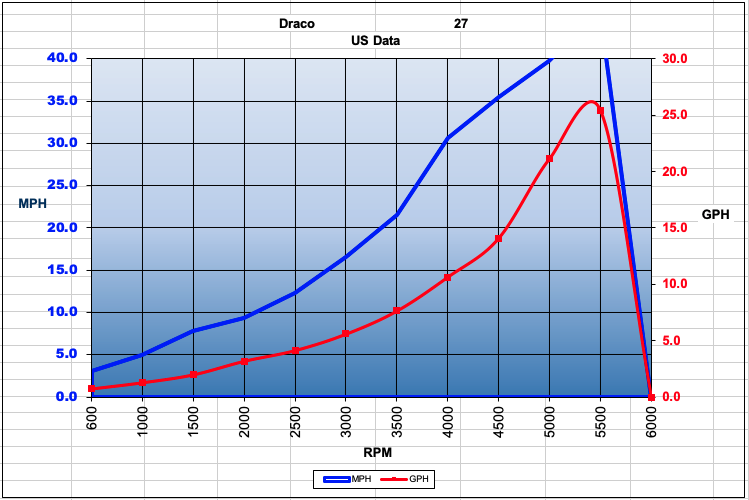
Specifications
| Length Overall |
27'3" 8.3 m |
|---|---|
| Beam |
8'2" 2.48 m |
| Dry Weight |
4,189 lbs. 1,900 kg |
| Bridge Clearance |
56" 142.24 cm |
| Fuel Capacity |
60 gallons 227 L |
| Water Capacity |
10.57 gallons 40 L |
Acceleration Times & Conditions
| Props | Mirage Plus 15 ¼” x 19” |
|---|---|
| Load | 3 persons; 50% fuel; no water; 50 lbs. gear |
| Climate | 57 deg.; 62 humid.; winds: 10-15; seas: 1-2 |
Engine Options
| Tested Engine |
1 x Mercury Verado 300 |
|---|
Captain's Report
By Eric Colby
Brief Summary
The Draco 27 is a retro-styled dual console that has a mini-expedition feel. She’s powered by a single outboard and has convertible seating in the cockpit. For overnighting, owners can opt for a camper canopy, a refrigerator, a head and a shower.
Draco 27 Key Features
- Single outboard power
- Stainless-steel windshield frame w/walk-thru center section
- Beach boarding ladder
- Back-to-back seat converts to sunpad
- Teak cockpit table
- Sink
Mission Statement
The Draco 27 is designed to be a versatile dayboat with deep cockpit and bow seating and myriad lounging options. She’s powered by a single outboard up to 400 hp and built with top-shelf materials and accessories. Draco calls her a “small super yacht.” Her plumb bow and angular lines give the 27 a certain Euro flair.
Company History. Kåre Drangsholt founded Draco Boats in Norway more than 50 years ago. Hochmuth Bootsbau AG in Stansstad, Switzerland became one of the first Draco dealers and delivered more than 5,000 boats for the company. The business still works with the modern-day version of Draco today. The naval architecture for the new series of Dracos was done by Hans Jorgen Johnsen, while the exterior design and styling were from Ed Dubois and the Windy Design Team.
Draco 27 Features Inspection
The Stern. When doing so from docks, the easiest way to board the 27 would be to step on the twin swim platforms that extend aft past the single outboard. The platforms have an average width of 2’ (60.96 cm) and measure 19” (48.26 cm) fore to aft. Forward, a raised aft deck is 85” (215.9 cm) wide and 34” (86.36 cm) deep. A four-step ladder is underneath the starboard platform and it secures in place with a bungee cord. There are stainless-steel framed gates that close the passage to the aft decks. Outboard on each side in the caprail are caprails and below, heavy-duty 8” (20.32 cm) cleats are mounted to the inwales. There are two more sets of the same sized cleats at amidships and at the bow. Just ahead in the starboard inwale is a rack to hold the optional stainless-steel ski tow pylon that threads in place just ahead of the splashwell. The well has an inspection hatch for accessing the trim and bilge pumps and wires, cables and hoses are cleanly rigged, running through plastic conduit that links the motor and the transom.
The Bimini Top
Draco provides a smart solution for storing the Bimini top. Part of the aft deck is hinged and when the top is collapsed, it stows beneath it. The only suggestion we would have is to put a small rubber bumper on the inwale so the hatch doesn’t hit it when raised. When the Bimini top is raised, the frame slides forward on aluminum tracks on each side of the cockpit. Forward and aft straps secure the top when it’s raised. When fully deployed, the Bimini top is 100” (254 cm) long and headroom underneath it is 75” (190.5 cm).
The Cockpit. In the center of the cockpit is a back-to-back lounge that can seat four (two facing forward, two aft) or be laid flat to create a large sunpad. An example of the upscale treatments throughout the boat, the lounge is upholstered in material from the Spradling-Marlin collection. There’s storage in the base of the center lounge and outboard in the gunwales. Expandable net pockets are mounted on vinyl curtains that snap in place in the inwales. This is a smart idea because they can be removed for off-season repair or storage. Our test boat had the optional Isotherm drawer-style refrigerator on the starboard side of the cockpit lounge base. Opposite to port is the manual bilge pump.
The Helm. The captain and a companion travel in bucket seats that swivel, slide fore and aft and have adjustable height. Ahead of the port seat is a stainless-steel grab rail. To starboard, the helm has a tilt steering wheel with an embossed Draco logo. Our test boat had the 12” (30.48 cm) Raymarine hybrid touch plotter in the center of the dash with a Mercury Smartcraft screen to starboard. On the left side of the steering wheel are a beverage holder and accessory-switch panel. Opposite, Draco equipped our boat with the optional bow thruster joystick, the Fusion stereo head, Zipwake interceptor panel, Mercury’s ActiveTrim controls and the Windlass button. Below are additional accessory switches. Aft are the digital throttle and shift control with the ignition switches and emergency shutoff lanyard. USB and auxiliary ports are underneath the panel as are the circuit breakers, and there’s an inspection panel for accessing the controls. Outboard on each are glovebox-style lockers.
The Port Console. The captain and a companion travel in bucket seats that have foldup bolsters, swivel, slide fore and aft and can have adjustable height. The port console has a stainless-steel rail wrapped in leather and it opens to reveal a sink, plus a compartment that has 40” (101.6 cm) of headroom and plenty of room for an optional head.
The Bow. Open the center section of the windshield and the to head forward to the Draco 27’s bow. There’s also an acrylic air dam to close off the 21”-wide (53.34 cm) walkway. There’s seating for six on lounges that measure 73” (185.42 cm) and 66” (167.64 cm). The boat also deep freeboard from bow to stern. We measured it at 38” (96.52 cm) in the bow, 32” (81.28 cm) amidships and 22” (55.88 cm) at the stern. In an impressive display of craftsmanship, the stainless-steel anchor integrates cleanly into a pulpit made of the same material. There’s storage underneath the side lounges in the bow and a panel in the deck provides access to the optional bow thruster. For access to the foredeck, the backrest in the bow pulls aside and a teak step folds down. Our test boat had the optional windlass beneath what would traditionally be the anchor locker hatch. Inside are heavy-duty rollers a cleat for securing the rode and storage for 328.1’ (100 m) of stainless steel chain that comes with the windlass package.
Draco 27 Performance
The 27 is powered by a single outboard up to 400-hp, so we’re going to start with the performance. Our test model has a 300-hp Mercury Four-Stroke outboard bolted to the transom and it includes an Advanced Midsection. She has an LOA of 27’3” (8.28 m), a beam of 8’2” (2.49 m) and a hull draft of 16 3/4” (42.43 cm). With an empty weight of 4,189 lbs. (1,900.1 kg), 27 gallons (102.21 L) of fuel, no water, three people and test equipment on board, we had an estimated test weight of 5,556 lbs. ( 2,520.15 kg).
Our test boat spun a Mirage Plus 15 ¼” x 19” (38.74 cm x 48.26 cm) stainless-steel three-blade prop through a 1.85:1 reduction. At 5500 rpm, we hit our top speed of 45.7 mph. Best cruise came at 4000 rpm, where we measured 30.6 mph and burned 10.7 gph. This gave us 2.69 mpg and a range of 155 statute miles with 10 percent of the boat’s 60.76-gallon (230.01 L) fuel capacity held in reserve. The minimum planing speed was 12.1 mph. At 600 rpm, the boat ran 3.2 mph and burned .8 gph, giving the boat a rating of 4.2 mpg. Bump up to 1000 rpm and the speed goes up to 3.2 mph with a fuel burn of 0.8 gph and 3.8 mpg.
In acceleration tests, the Draco 27 planed in 3.6 seconds. She ran through 20 mph in 4.5 seconds and through 30 mph in 6.8 seconds.
The Draco 27 has an ax-style or plumb bow with a sharp entry and the bottom has approximately 23 degrees of deadrise at the transom. Six strakes run the full length of the hull and she has a hard chine, plus a raised spray rail. That rail came in handy on our test day that brought steady 15-mph winds with gusts over 20 and steady 2’ chop. In maneuvers our test boat handled well, holding her line through sweeping arcs without getting blown off course. She crisscrossed our photo boat’s wakes with ease. When the time came to pull alongside the dock, the optional bow thruster made the task effortless.
Draco 27 Construction
Draco builds the 27 with a vinylester skin coat backed up by alternating layers of hand-laid fiberglass mat and vinylester resin. A couple of noteworthy items are the rubrail that is one of the most substantial we’ve seen on any size boat and that our test boat’s blue hullsides were finished in a vinyl wrap over the white gelcoat. Draco will also paint the hullsides in polyurethane paint like Imron or Awlgrip.
Retail Price as Tested
$179,000 with a 300-hp Mercury Verado outboard, trailer, vinyl wrap, Isotherm refrigerated drawer, Bimini top, Zipwake interceptors, Fusion stereo and 12” ( 30.48 cm) Raymarine chartplotter.
Options to Consider (Not discussed in report)
- Bow dodger
- Cockpit deck lighting
- Swim platform lights
Observations
The Draco 27 could have just enough of a retro/Euro look combined with a versatile cockpit layout to crack the U.S. dayboat/dual-console market. The boat has a kind of straightforward, open concept that lends itself to a variety of activities, and it makes it easier to enjoy them. The absence of carpet and exotic upholstery means she can be sprayed out with a hose at the end of the day. The lack of USB ports for every seat lets the kids set aside their smartphones and reconnect with each other and the environment and enjoy being out on the water.

